








































Storm devastation hit Florida twice in two weeks after Hurricanes Helene and Milton struck the Sunshine State on Sept. 26 and Oct. 9.
The storms caused fierce winds, flooding rains and rising seawaters, and knocked out electricity to hundreds of thousands of Florida co-op members.
Milton caused dozens of tornadoes in the state even before it made landfall near Sarasota, Florida, as a Category 3 hurricane with sustained winds of 120 mph.
For Hurricane Helene, Mississippi sent 280 men from 20 systems — Coast, 4-County, Tombigbee, Delta, Dixie Electric, East Mississippi, Magnolia, North East, Northcentral, Singing River, Southern Pine, Tishomingo, Yazoo Valley, Alcorn, Tallahatchie Valley, Pontotoc, Natchez Trace, Prentiss, Southwest, and Pearl River Valley.
Mississippi linemen also were dispatched to Georgia to help restore power after Helene struck. Men from Tippah Electric, Central, and Twin County joined the Georgia e ort with workers from the co-ops mentioned above. Mississippi had 121 men working in Georgia. Some of those linemen were there following their work in Florida, others were switched out, and some were sent to Georgia directly from their home co-ops.
Following landfall of Milton, Mississippi sent 145 men to assist Florida co-ops.
While Mississippi linemen answered the call to assist Florida and Georgia co-ops in their time of need, life went on at home in their absence.
Dixie Electric lineman Brady Creel was working in Florida even though his wedding was scheduled for Oct. 19.
Brady and his fiancée Emily Holder told Mississippi TV stations that they knew his time to go would come. They just hoped it wouldn’t be so close to their wedding day.
Holder said her fiancé was given the option to sit this trip out, but he chose to put the needs of others before himself.
There’s still a plan to make sure he’s back in time to say his vows.
“I have an aunt who’s just making the extra trip to get him,” Holder
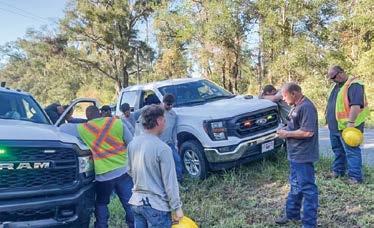

said. “It’s like an hour and a half extra for her, and then she’s going to drive him home.
At the time of this writing, the couple’s wedding was still scheduled for Oct. 19, Holder said.
Yazoo Valley Electric lineman Justin Milner was working in Florida to restore power after Milton and was surprised with a gift from Florida co-op Peace River Electric.
While Milner was away from home, he had to miss his baby’s gender reveal.
“To show our gratitude for his hard work and sacrifice, we gifted him something special to celebrate the upcoming arrival of his little one,” Peace River Electric posted on their Facebook page.
“Moments like these remind us that the cooperative di erence goes far beyond power lines — it’s about people, family, and community.”
Turns out, Milner is going to be a girl dad.
The Mississippi Public Service Commission (MPSC) recently announced the establishment of a strategic alliance with law enforcement agencies and utility organizations to provide additional resources for the state’s AMBER Alert program.
Led by Southern District Commissioner Wayne Carr, the initiative recognizes the critical role that utility workers can play in resolving AMBER Alerts. Many utility professionals — like utility linemen and utility operators — perform their job duties
outdoors by streets and residential areas, which provides a unique opportunity for these professionals to spot individuals and vehicles included in an AMBER Alert.
“Given the nature of their jobs, utility representatives can play a crucial part in our state’s AMBER Alert program by recognizing the signs of child abduction and understanding how to best respond in
these types of situations,” Carr said in a news release. “We are excited to create a partnership with statewide law enforcement agencies and utility organizations in order to provide safety education to utility crews and to contribute to Mississippi’s strong AMBER Alert network.”
Through this innovative partnership, the MPSC, the Mississippi Department of Public Safety, the Attorney General’s O ce, electric cooperatives, water companies, and natural gas providers will collaborate to educate utility employees on the state’s AMBER Alert program and train them to recognize the signs of child abduction.
Additionally, a social media campaign and the distribution of informative materials will accompany the utility training program, further disseminating this initiative’s goals and messages to residents across Mississippi.



“Improving the quality of life for all those we touch.”
I love the feeling of being able to walk into my favorite locally-owned shop, restaurant or store knowing that the profit, product and labor can make positive impacts on my community. The spirit of main street is embodied in these local businesses, just like it is in 4-County Electric Power Association.
Electric cooperatives are as local and community centered as they come. Founded as a way to bring electricity to communities that didn’t interest Investor-owned utilities (or IOUs), electric cooperatives have been a cornerstone of community and economic development in rural America and beyond for decades.
That feeling I get when I frequent local businesses in our community is the same feeling I get when I walk into work at the co-op every day. It is a feeling of thankfulness. I am thankful to be a part of an organization that serves the community in which we live, instead of a group of shareholders who may never have set foot in our service territory.
At 4-County, we celebrate the co-op way of life on a daily basis. Living on co-op lines is more than just knowing there are people out there working to bring you safe, reliable and a ordable electric service. Living on co-op lines is an investment in our community and its members.










You see, 4-County is a not-for-profit business. This means after all co-op expenses are paid, any additional money goes back into the co-op’s infrastructure, instead of going into a shareholder’s pocket, which is pretty great!
And because we are owned by you, our members, we have a vested interest in making sure our community is prosperous. We do this by investing in economic development and community service projects, programs such as the 4-County Foundation and the Cooperative Youth Leaders program.
I hope that you view 4-County not just as your electric utility provider, but as a local business that brings pride and prosperity to our community. If you are interested in learning more about how we keep the lights on and beyond, please stop by the co-op or give us a call. We love being a part of this community, and we hope you feel the same way too!
We’re thankful for you! Happy Thanksgiving!

by Brian Clark
CEO/General Manager
We like to think of FASTnet as a family and we’d like you to help our family grow! As a FASTnet customer, you can earn a $25 bill credit for every new customer you refer.*
Just make sure that any new customer you send our way knows your name and FASTnet account number and that they give it to us when they sign up for service. For every new customer you refer to FASTnet that gets installed, we’ll put a $25 credit on your bill. So, help us spread the word about FASTnet and earn a little money while you do it.
*Referral information must be given before account is installed. Credits will be applied to the referrer’s account as a credit only and cannot be redeemed for cash.

















4-County Electric Power Association and FASTnet are encouraging members and customers to help make Christmas better and brighter for area children by taking part in their annual Toy Drive.
Drop-o boxes will be located in 4-County o ces this month through Dec. 13. The co-op is asking its members, employees and the general public to drop o a new, unwrapped toy in one of the boxes located in the 4-County o ce nearest you.
Collected toys will be delivered to the Salvation Army who will distribute toys throughout the 4-County service area. Last year, employees and members dug deep and collected nearly 300 toys for distribution in 4-County’s service area.
“This is a great Christmas project,” said 4-County Senior Communications Coordinator Brad Barr. “We’re always excited to participate in our annual Toy Drive. A lot of children identified by Salvation Army wouldn’t have the same Christmas experience without the help of this charitable organization and organizations like 4-County.
Again, the deadline for dropping o toys is Dec. 13. Call Barr at 1-800-431-1544 for more information about the annual Toy Drive project. (Note: Special arrangements to pick up toy donations can also be made by calling Barr).






4-COUNTY’S ANNUAL
DROPOFF LOCATIONS:
4COUNTY OFFICES DEADLINE:





Help make things a little easier for area families during the upcoming Thanksgiving and Christmas holidays by collecting food items for The Giving Hands Food Pantry.




How can you help? Employees and members can bring food items (canned goods, boxed items and pull-tab items) to 4-County o ces Nov. 21 and place them in the collection utility bucket. “The Fill a Bucket program will fill a big need in area communities,” said 4-County CEO Brian Clark.




For more information, call 4-County’s Marketing Department at 1-800-431-1544.










DEADLINE NOV. 21






















Joe MacGown is creating a real buzz in the world of art.
The Starkville resident is drawing worldwide attention to his detailed, surreal drawings and art projects that feature insects and other natural history themes.
MacGown, a self-taught and scientific-acknowledged expert on ants, has shown and sold his work around the world. He has also had feature appearances on programs at television networks like Animal Planet.


His intricate creations of art are displayed primarily as colored inks on paper, wood, clay-coated board, and metal. Sketches complete an expansive portfolio.
MacGown briefly attended art school at Memphis College of Art. He later received a job at Mississippi State University (MSU) as a scientific illustrator for the Mississippi Entomological Museum. This job evolved into a research position over time.
He began his artistic journey at 4 and sold his first painting at 11. “Everything I see is complex, and brimming with subject matter, rather than open spaces. I see the world in a di erent way,” MacGown explained. To create his art, he allows his observations and thoughts to flow from his brain freely in what he calls “subconscious meandering.”




researcher. Joe spent part of his childhood in Maine and part of his childhood in Mississippi (following his father and family to an academic gig at Mississippi State University). “I was a nature nut. I grew up without television,” Joe said of his childhood experiences in those bountiful outdoor settings. Not much has changed, he admitted. “I continue to observe nature, seeing things that I draw inspiration from.”


The insect aficionado comes naturally by his interest in arthopods. His father, with a PhD in Entomology, was a university

In 2020, he retired from full-time work at MSU. Now, he works part-time there, conducts research, and stays busy with his art. Through the years, he has created thousands of art projects, sometimes investing hundreds of hours in each piece of large art.
MacGown creates much of his detailed works in a 600-square-foot studio on his 17 acres in the Sessums Community of Oktibbeha County. He lives there with his wife, Jennifer, and his stepdaughter, Emma Claire. He shares studio space with his son, Joseph. The MacGown Art Retreat and Studio includes the MacGown’s home, a studio, a cabin, an “art house,” — where visiting artists stay — and a gallery featured in a picturesque expanse around the lake. “It’s a good place to create.”



Art should be an expression of oneself, he said. “Everyone has some form of artistic ability. Finding that type of art may be the challenge. You must stick with it. But it’s a beautiful journey.”






comforts of her own home.
The avid reader says books can take you places you never imagined. “You can experience a lot through reading. It takes you places. And you don’t even have to have a ticket,” Paula explained.
Thrillers and romantic comedies are her book genres of choice. “I just enjoy it. It’s a relaxing hobby,” she added.
The Michigan native and her son, Howard, 6, live in Noxubee County. “He loves to play,” she said of Howard. “If that was a job, he’d be excellent at it,” she said with a laugh. “We have a good time.”
Paula and Howard live and thrive in the countryside of the county. They have 20 cows, a vegetable garden, and fruit trees. Two farm greeters/watchdogs, Tina and Red, a pair of strays that quickly became part of the family, watch for visitors. “They just showed up and blended right in.” A seasoned horse, also named Red, rounds out the group of four-legged friends.
Paula says she left the Wolverine State for the Magnolia State to be closer to family. The Noxubee County clan lives within 10 minutes of each other. “We have a large family. It’s kind of like our own community. We help each other out and provide support to each other,” Paula said.


She also enjoys providing support to 4-County Electric Power Association members as a member services representative, based at the co-op’s Starkville o ce. Paula assists 4-County members with questions about their accounts and about the co-op. “We provide information and solutions. You get to know the customers. You’re dealing with di erent personalities. A simple solution can sometimes make someone’s day.”
Paula joined 4-County in February 2023. Prior to working at the co-op, she served a stint as a customer service representative for Cadence Bank. She attended East Mississippi Community College and is now studying business administration with an emphasis in human resources at Devry University.
As a young adult searching for a career, Paula knew she wanted to help people. “I’m able to do that here.“ Employees at the call center department, where Paula most often works, handle between 70 to 100 phone calls each day.

Family is important to Paula, she stressed. And 4-County has proven to be a home away from home. “We all look out for each other. We’re like a family,” she said. “And it’s great that we help the community where we can. I appreciate our reputation. We’ve good a good one. I like being part of that. People look at you with respect.”





















































A tradition of dependable, hometown service since 1937


CARTHAGE: 601-267-5671 | PHILADELPHIA: 601-656-2601 | RANKIN: 601-829-1201 | SEBASTOPOL: 601-625-7422





Three area high school juniors were recently selected through an interview process to represent Central Electric Power Association during an upcoming statewide leadership workshop in Jackson, MS, and the annual National Rural Electric Cooperative Association Youth Tour in Washington, D.C. this summer.
Now in its 38th year, the Electric Cooperatives of Mississippi Cooperative Youth Leaders program is an enjoyable educational experience that makes a lasting impact on participants. The Cooperative Youth Leaders program provides an opportunity for students across Mississippi to learn, grow, and experience.
Students LEARN the value of the cooperative business model, specifically the impact that electric cooperatives have on their lives and communities.

An Le is the daughter of Xin Tran and Binh Le of Philadelphia. She attends Neshoba Central High School. After graduation, An plans to pursue a degree in mathematics and chemistry.

GROW in their leadership qualities through team-building exercises as well as expanding their communication skills, confidence, and courage in decision making.

Emily Ingram is the daughter of John and Sissy Ingram of Brandon. She attends Northwest Rankin High School. After graduation, Emily plans to pursue a degree in secondary education and theatre performance.

EXPERIENCE the democratic process at state and federal levels by visiting the Mississippi and U.S. capital cities.

Hayes Haney is the son of Kent and Robin Haney of Brandon. He attends Northwest Rankin High School. After graduation, Hayes plans to pursue a degree in veterinary science.





Lighting of the Tree On the Square
November 21
6 p.m.
Christmas Open House KAP o ce
November 24 1 - 4 p.m.
Merry Market Place KAP o ce
November 24 - December 19
8 a.m. - 5 p.m., M-F
Christmas Parade Downtown Square
December 2
6 p.m.
Holiday Open House
November 10
1 - 5 p.m.
Carthage Christmas Parade and Lighting of the Park
December 5
6 p.m
Walnut Grove Christmas Parade
December 6
6 p.m.
Carthage Jingle and Mingle
December 12

Christmas Open House
November 10
1 - 5 p.m.
3rd Thursday
November 21
6 - 9 p.m.
Small Business Saturday
November 30
Christmas Parade
December 9 6 p.m.
Moonlight Madness
December 12
6 - 9 p.m.
3rd Thursday
December 19
6 - 9 p.m.
Christmas Parade Main Street
December 5 6 p.m
Tour of Trees Gala McElroy-Hoye House
December 7
5 - 7 p.m
A Merry Newton Christmas Tour of Trees McElroy-Hoye House
December 9-13

Brandon Magic of Lights The Quarry November 22 - January 5
6 - 9 p.m, Monday-Thursday 5 - 10 p.m., Friday-Sunday magicoflights.com/locations/brandon-ms
Flowood Chili Cook-O and Grand Lighting of Winter Circle Park
December 5 5:30 - 8 p.m
Holiday Market Downtown November 16
9 a.m. - 2 p.m
Forest Christmas Parade December 6 6 p.m
Passport to Santa December 7
9 a.m. starts at the library
For more information, see the Forest Area Chamber Facebook page.
Please contact your local Chamber of Commerce to confirm all events.























































































How can smart home technology help me lower my power bill?


by Miranda Boutelle
When upgrading to smart technology at home, consider the purchase cost as well as long-term savings. For example, you may pay a little more for a product with the latest technology, but it could result in significant savings each year and over the lifetime of the appliance.
Here are some smart devices that will take the work out of saving energy.
Smart thermostats save energy by automatically adjusting your heating or cooling system. For example, you can save as much as 10% a year on heating and cooling costs by adjusting your thermostat 7 to 10 degrees from its normal setting for eight hours a day, according to the Department of Energy (DOE).
You can program a smart thermostat to change the temperature when you are asleep or away, or use a smartphone app to adjust your thermostat settings. Some models use artificial intelligence to maximize e ciency by learning your patterns and preferences. Prices range from $80 to $250, depending on features. Smart thermostats do not work with all heating and cooling systems, so check compatibility before you buy. Your water heater can also be controlled for energy savings. Installing a timer on your electric water heater can save 5% to 12% of the energy it uses by turning it o at night and when you don’t need to use hot water, according to the DOE.








Smart technology can make it easier to save energy by simplifying or automating tasks. It can also optimize energy use to reduce waste and improve e ciency.
Smart lighting gives you the power to control lights in your home remotely or set a lighting schedule that fits your lifestyle. This can be beneficial for energy savings and provide home security benefits. If you or other members of your household are notorious for leaving lights on, smart lighting can help. Numerous features are available, including dimmable bulbs and color-changing e ects.
Smart light switches are another budget-friendly way to control lighting. They’re priced from about $10 to $50. Smart switches with dimmable options are available and can also control ceiling fans. Some have occupancy sensors that turn lights o when no movement is detected in a room.

Smart heat pump water heaters are equipped with automation features that help you use less energy. Photo Credit: Northwest Energy E ciency Alliance
If you are already planning to replace your electric storage water heater with a heat pump water heater, consider a model equipped with smart technology features, including Wi-Fi capabilities for controlling it remotely or during peak demand times, viewing the amount of hot water available and tracking energy use. There are a variety of modes, including vacation, e ciency and high demand, which produces more hot water. Some models can notify you or shut o if a leak is detected. Depending on the manufacturer and size of the unit, a smart heat pump water heater may only cost a few hundred dollars more than a standard heat pump water heater.
A smart plug fits into any outlet to control whatever is plugged into it. Set them to automatically turn o and on or control them using a smartphone app. Prices range from $8 to $25.
A wide variety of smart shades, curtains, and blinds are available, including styles with integrated controls. You can also add smart controls to your existing blinds or curtains. Both options allow you to adjust the tilt of blinds and open or close curtains. Set a schedule, control them remotely or use a voice command paired with a voice assistant, such as Alexa or Google Home. This allows you to reduce cooling needs in the summer and heating needs in the winter. Smart controls start at around $70. To save the most energy, prioritize windows with the most incoming light.
Upgrading to smart home technologies can make it easy to use less energy at home. Choose options that make the most sense for your lifestyle to optimize savings.
Miranda Boutelle is the chief operating o cer at E ciency Services Group in Oregon, a cooperatively owned energy e ciency company.


















by Qua’Shara Monix













November is a month steeped in reflection, gratitude, and the honoring of sacrifice in the United States. Two significant national holidays, Veterans Day and Thanksgiving, serve as pivotal moments in this shared cultural experience. While the origins and purposes of these holidays are distinct, they are united by common themes of thankfulness, sacrifice, and the enduring spirit of community. Exploring the connection between Veterans Day and Thanksgiving reveals a deeper understanding of why November is a time for appreciation and reflection on the values that bind the nation.
As we approach Veterans Day, it’s important to pause and reflect on the sacrifices and dedication of those who have served in the Armed Forces. We want to extend our deepest gratitude to a special group of people — our co-workers who are veterans. Your service to our country has not only ensured the freedoms we enjoy daily but has also shaped the values and skills you bring to the workplace. Veterans are known for their leadership, resilience, and commitment — qualities that extend beyond the battlefield and into every area of life, including the professional world. Whether in the military or here at work, your strong sense of responsibility, teamwork, and problem-solving ability continue to inspire those around you.









cepa@coahomaepa.com













The same dedication that allowed you to serve our country so honorably now helps drive our shared success in the workplace. On Veterans Day, we honor your service, but it’s important to acknowledge that your contributions didn’t end when you took o the uniform. Every day, you continue to make a lasting impact. Whether through mentoring others, leading by example, or simply being someone your coworkers can count on, your influence reaches far and wide.







As the air turns crisp and autumn settles in, November o ers the perfect backdrop for reflection. Veterans Day and Thanksgiving stand as bookends to a month that encourages us to remember, appreciate, and give thanks for the blessings that define American life. By honoring veterans and celebrating the spirit of gratitude, we can find a deeper sense of connection to both the past and the future. These holidays remind us that freedom and abundance are not guaranteed — they are earned, protected, and shared. And in that, November becomes a month of both remembrance and thanksgiving. Thank you for everything you’ve done for our country, and thank you for everything you continue to do as part of our team. Your service is deeply appreciated, and we are proud to work alongside you.























Coahoma Electric donated peanut butter and jelly to the Clarksdale Care Station, a local community food pantry. The pantry accepts donations from 8 a.m. to 11 a.m., Monday through Friday.





































How can smart home technology help me lower my power bill?
by Miranda Boutelle
When upgrading to smart technology at home, consider the purchase cost as well as long-term savings. For example, you may pay a little more for a product with the latest technology, but it could result in significant savings each year and over the lifetime of the appliance.
Here are some smart devices that will take the work out of saving energy.
Smart thermostats save energy by automatically adjusting your heating or cooling system. For example, you can save as much as 10% a year on heating and cooling costs by adjusting your thermostat 7 to 10

Smart technology can make it easier to save energy by simplifying or automating tasks. It can also optimize energy use to reduce waste and improve e ciency.
degrees from its normal setting for eight hours a day, according to the Department of Energy (DOE).
You can program a smart thermostat to change the temperature when you are asleep or away, or use a smartphone app to adjust your thermostat settings. Some models use artificial intelligence to maximize e ciency by learning your patterns and preferences. Prices range from $80 to $250, depending on features. Smart thermostats do not work with all heating and cooling systems, so check compatibility before you buy.

Your water heater can also be controlled for energy savings. Installing a timer on your electric water heater can save 5% to 12% of the energy it uses by turning it o at night and when you don’t need to use hot water, according to the DOE.
If you are already planning to replace your electric storage water heater with a heat pump water heater, consider a model equipped with smart technology features, including Wi-Fi capabilities for controlling it remotely or during peak demand times, viewing the amount of hot water available and tracking energy use. There are a variety of modes, including vacation, e ciency and high demand, which produces more hot water. Some models can notify you or shut o if a leak is detected. Depending on the manufacturer and size of the unit, a smart heat pump water heater may only cost a few hundred dollars more than a standard heat pump water heater.
Upgrading to smart home technologies can make it easy to use less energy at home. Choose options that make the most sense for your lifestyle to optimize savings.

Smart lighting gives you the power to control lights in your home remotely or set a lighting schedule that fits your lifestyle. This can be beneficial for energy savings and provide home security benefits. If you or other members of your household are notorious for leaving lights on, smart lighting can help. Numerous features are available, including dimmable bulbs and color-changing e ects.
Smart light switches are another budget-friendly way to control lighting. They’re priced from about $10 to $50. Smart switches with dimmable options are available and can also control ceiling fans. Some have occupancy sensors that turn lights o when no movement is detected in a room.
A smart plug fits into any outlet to control whatever is plugged into it. Set them to automatically turn o and on or control them using a smartphone app. Prices range from $8 to $25.


A wide variety of smart shades, curtains, and blinds are available, including styles with integrated controls. You can also add smart controls to your existing blinds or curtains. Both options allow you to adjust the tilt of blinds and open or close curtains. Set a schedule, control them remotely or use a voice command paired with a voice assistant, such as Alexa or Google Home. This allows you to reduce cooling needs in the summer and heating needs in the winter. Smart controls start at around $70. To save the most energy, prioritize windows with the most incoming light.
Upgrading to smart home technologies can make it easy to use less energy at home. Choose options that make the most sense for your lifestyle to optimize savings.

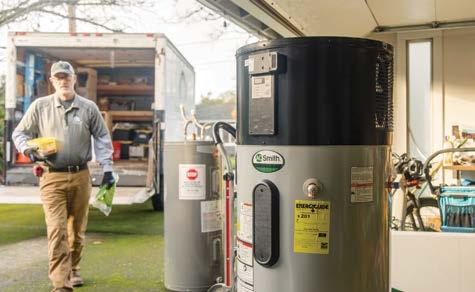




















by Scott Flood


You might be surprised to learn that your local electric cooperative doesn’t generate the electricity you use in your home or business. In most cases, your co-op does not own a power plant but instead purchases electricity from an outside source, then routes the power to your community.
For more than 800 electric cooperatives across the country, the source for electricity is a di erent kind of cooperative. Referred to as “G&Ts,” these Generation & Transmission cooperatives exist to help electric co-ops serve their members as reliably and a ordably as possible. Their only members are local electric co-ops, so G&Ts are actually cooperatives that serve — you guessed it — cooperatives.
Across the nation, 64 G&T cooperatives provide access to wholesale (at-cost) power at a better price than each of their member co-ops could obtain on their own. Most G&Ts go beyond the delivery of power to provide sophisticated business resources that would normally be out of reach for local co-ops.
Like your local co-op, G&Ts are not-for-profit organizations that exist to serve the needs of their members. G&Ts generally serve all the co-ops in a specific geographic area.
Cooperative Energy is a G&T in Mississippi. The Tennessee Valley Authority is a public power entity that serves the G&T function in part of the state.
G&Ts employ a leadership team of experts in data, finance, engineering, economic development, environmental management and other important specialties that are essential for electric co-ops. The G&T operates behind the scenes to support the local co-op’s teams, and although G&Ts may be largely unseen, they operate with complete transparency.
G&Ts are best known as the source for at-cost electricity that is generated elsewhere, then delivered to your local co-op over high-voltage transmission lines. Your co-op uses distribution power lines and transformers to then deliver that electricity to your home or business.
Most G&Ts maintain their own power plants, while others purchase power for their members on the wholesale market. Some G&Ts manage a combination of native power generation and purchases. Because a G&T buys enough power to supply all of its member co-ops, it has the bargaining power to secure significantly lower prices than those co-ops could negotiate by themselves. Regardless of how they’re structured, G&Ts help keep your electric bill smaller.
Just as important is the work G&Ts perform in planning. The nation’s energy landscape is changing rapidly. G&Ts constantly work with local co-op sta to study and forecast power needs. They consider how growing communities might a ect the demand for







electricity in the future and work closely with local co-ops when power reliability is challenged, such as times when electricity demand outpaces supply or after a major weather event.
In addition to obtaining the electricity local co-ops need, G&Ts improve and maintain the reliability of the infrastructure co-ops and their communities depend upon. By working with local co-op sta to upgrade transmission lines and deploy substations, they make sure the power will be there for members, like you, when you need it. G&Ts also work closely with government agencies that monitor and manage the nation’s electric grid.
So, while your co-op may not own the power plant that generates the electricity you use every day, it’s part of an even bigger not-forprofit cooperative whose mission is to make your service even more reliable and a ordable. As the power behind your power, just like your electric co-op, G&T cooperatives exist to serve you.
For more than four decades, business writer Scott Flood has worked with electric cooperatives to build knowledge of energy-related issues.









































































































































As November kicks o , it’s hard to believe we’ll soon be gathering with family and friends to celebrate the holiday season. This festive time of year brings joy and warmth, but as the weather gets cooler and we spend more time indoors, the holidays can also bring increased energy use and a higher risk of electrical and fire hazards.
As your local electric cooperative, our team at Coast Electric cares about your well-being. This month, I’d like to share a few practical tips to help you stay safe and e cient during the holiday season.
My family truly enjoys decorating our home for the holidays. Before we deck the halls, I always check electrical cords and light strands to make sure they aren’t frayed or damaged. This gives us peace of mind, knowing our holiday lights are ready to safely brighten our home. I also double check the lights we use outside to make sure they’re rated for outdoor use.
Like many households, we also enjoy holiday-scented candles. While festive, candles can create fire hazards and should never be left unattended. One of the best and easiest ways to safeguard your home is to test smoke alarms often. I test mine on the first of each month, so it’s easy to remember. Testing smoke alarms only takes a few seconds and could save lives, so make it a habit.
Spending more time indoors with a few more guests in the home can really impact home energy use. By taking a few small steps to save energy during the holiday season, you can lower your bills. I like to remind my family members to mind the thermostat. Since heating and cooling makes up the majority of home energy consumption, the thermostat is one of the best places for savings. Lower it a few degrees, especially when you have family or friends stopping by. Good company brings additional warmth to your home.
Your family can also save energy by decorating with LED holiday lights. LEDs are the most energy-e cient lighting options available, and they last much longer than traditional bulbs.
There’s no denying one of the best parts of the holiday season is the food — not just the meals but the time we spend together in the kitchen. There are many ways to save in the heart of your home, but one of the best approaches is to cook with smaller countertop appliances, such as air fryers, slow cookers and toaster ovens. These handy appliances consume a fraction of the energy used to heat the oven, creating the perfect recipe for mealtime and energy savings.
I hope you will implement some of these energy-saving and safety tips into your holiday plans. For additional advice, visit our website at www.coastelectric.coop. We’re here to help you with safety and savings year-round.
From your friends at Coast Electric, we hope your holiday season is merry and bright.

by Ron Barnes
President and CEO




COAST ELECTRIC AND COASTCONNECT OFFICES WILL BE CLOSED MONDAY, NOV. 11, ON VETERANS DAY.
Coast Electric dispatchers will be on duty, and crews will be on call. If you need to report an outage, you can text us at 228-338-4644. If you have a mobile number associated with your account, report your outage on www.coastelectric.coop, use our CE on the Go app or call 877-769-2372.
For 24/7 tech support with CoastConnect, chat online at www.CoastConnect.com or call 877-969-3884.


We o er our heartfelt gratitude to country. Thanks to Coast Electric’s and CoastConnect’s veterans:

Chris Westbrook
John Ziller
COASTCONNECT
Clay Hoppen
Cory Weschovich


Coast Electric and CoastConnect employees participated in the Heart Walk in Gulfport earlier this fall. The event raised more than $303,000, and Coast Electric and CoastConnect were recognized for being the company that raised the second highest amount of money. Thanks to our CEO, Ron Barnes, for his leadership as part of the Heart Walk executive leadership team and thanks to all who walked and raised funds for a worthy cause!

Coast Electric employees donated funds to help stock the shelves at local food pantries. The donations were part of a larger e ort of 11 Mississippi cooperatives to assist food-insecure residents in our service areas. Besides local food pantry donations, Coast Electric’s generation and transmission provider, Cooperative Energy, donated to Extra Table, an organization that provides food to food pantries and soup kitchens across the state. Showing concern for the communities they serve is part of every co-op’s mission, and we are proud to help organizations that make a positive di erence for our members. The Nugent Methodist Church Food Pantry, Crossroads Food Pantry and Hancock County Food Pantry all received donations from Coast Electric employees.





Coast Electric crew members, engineers, safety and vehicle maintenance personnel traveled to assist cooperative members who were impacted by Hurricane Helene. Coast Electric has received support in the past from the network of co-ops across the country, and we are proud to be able to provide the same service during this di cult time for other cooperative members. Crews have helped with restoration at Talquin Electric Cooperative and Suwannee Valley Electric Cooperative, both in Florida, and then made their way to Satilla Rural Electric Membership Cooperative in Georgia.
We recently visited Pearl River Community College and the Gulfport/Biloxi campus of Mississippi Gulf Coast Community College to register voters. We were able to register 45 new voters from 13 Mississippi counties that day! Coast Electric is encouraging members to vote as part of the non-partisan Co-ops Vote initiative. Co-op voters understand the unique issues our communities face and the opportunities we have. We are proud of the new voters we registered and encourage our members to vote in all local, state and national elections! You have the POWER to register. Be informed. Vote.










Coast Electric and CoastConnect o ces will be closed Thursday and Friday, Nov. 28-29, for the Thanksgiving holiday.
Coast Electric dispatchers will be on duty, and crews will be on call throughout the weekend. If you need to report an outage, text “outage” to 228-338-4644. If you have a mobile number associated with your account, report your outage on www.coastelectric.coop, use our CE on the Go app or call 877-769-2372.

For 24/7 tech support with CoastConnect, chat online at www.CoastConnect.com or call 877-969-3884 and select option 2.

We wish you and your loved ones a happy holiday, full of things that make you grateful.

Members are invited to our Energy Fair in Picayune on Friday, Nov. 15. Stop by to talk to our energy experts and learn how you can reduce your use and save! You will also be eligible to win door prizes and receive giveaways. We hope to see you there!
FRIDAY, NOV. 15
9 a.m. – 2 p.m.
Coast Electric Picayune O ce Hwy. 11


Join us for our Annual Meeting and Member Appreciation Night Thursday, Nov. 7, at the Coast Electric Robert J. Occhi Headquarters on Hwy. 603 in Kiln. Registration begins at 5 p.m., and the business meeting will be called to order at 6 p.m. Everyone who attends will be registered to win up to $1,000 in electricity credits from Coast Electric! We hope to see you there.
Can’t make it? Visit www.coastelectric.coop to watch a livestream of the event. Please note that only those in attendance at the meeting or those who registered by proxy can participate in the election process.
Coast Electric wants you to reduce your energy use and see savings on your energy costs. Each month, you will have an opportunity to register to win a prize that will help you reduce the energy consumption in your home. All you have to do is visit www.coastelectric.coop and fill out our entry form. It only takes a few seconds, and you could win a prize that helps you save!
Congratulations to Belinda Creel, the winner of our September Reduce Your Use prize!



























































As November kicks o , it’s hard to believe we’ll soon be gathering with family and friends to celebrate the holiday season. This festive time of year brings joy and warmth, but as the weather gets cooler and we spend more time indoors, the holidays can also bring increased energy use and a higher risk of electrical and fire hazards.
As your local electric cooperative, our team at Delta Electric cares about your well-being. This month, I’d like to share a few practical tips to help you stay safe and e cient during the holiday season.
My family truly enjoys decorating our home for the holidays. Before we deck the halls, I always check electrical cords and light strands to make sure they aren’t frayed or damaged. This gives us peace of mind, knowing our holiday lights are ready to safely brighten our home. I also double check the lights we use outside to make sure they’re rated for outdoor use.
Like many households, we also enjoy holiday-scented candles. While festive, candles can create fire hazards and should never be left unattended. One of the best and easiest ways to safeguard your home is to test smoke alarms often. I test mine on the first of each month, so it’s easy to remember. Testing smoke alarms only takes a few seconds and could save lives, so make it a habit.
Spending more time indoors with a few more guests in the home can really impact home energy use. By taking a few small steps to save energy during the holiday season, you can lower your bills.










I like to remind my family members to mind the thermostat. Since heating and cooling makes up the majority of home energy consumption, the thermostat is one of the best places for savings. Lower it a few degrees, especially when you have family or friends stopping by. Good company brings additional warmth to your home.
Your family can also save energy by decorating with LED holiday lights. LEDs are the most energy e cient lighting options available, and they last much longer than traditional bulbs.
There’s no denying one of the best parts of the holiday season is the food—not just the meals but the time we spend together in the kitchen. There are many ways to save in the heart of your home, but one of the best approaches is to cook with smaller countertop appliances, such as air fryers, slow cookers, and toaster ovens. These handy appliances consume a fraction of the energy used to heat the oven, creating the perfect recipe for mealtime and energy savings.
I hope you will implement some of these energy-saving and safety tips into your holiday plans. For additional advice, visit our website at www.deltaepa.com. We’re here to help you with safety and savings year-round.
From your friends at Delta Electric, we hope your holiday season is merry and bright.

by Harold Pittman
General Manager










































How can smart home technology help me lower my power bill?
by Miranda Boutelle
When upgrading to smart technology at home, consider the purchase cost as well as long-term savings. For example, you may pay a little more for a product with the latest technology, but it could result in significant savings each year and over the lifetime of the appliance.
Here are some smart devices that will take the work out of saving energy.
Smart thermostats save energy by automatically adjusting your heating or cooling system. For example, you can save as much as 10% a year on heating and cooling costs by adjusting your thermostat 7 to 10

Smart technology can make it easier to save energy by simplifying or automating tasks. It can also optimize energy use to reduce waste and improve e ciency.
degrees from its normal setting for eight hours a day, according to the Department of Energy (DOE).
You can program a smart thermostat to change the temperature when you are asleep or away, or use a smartphone app to adjust your thermostat settings. Some models use artificial intelligence to maximize e ciency by learning your patterns and preferences. Prices range from $80 to $250, depending on features. Smart thermostats do not work with all heating and cooling systems, so check compatibility before you buy.

Your water heater can also be controlled for energy savings. Installing a timer on your electric water heater can save 5% to 12% of the energy it uses by turning it o at night and when you don’t need to use hot water, according to the DOE.
If you are already planning to replace your electric storage water heater with a heat pump water heater, consider a model equipped with smart technology features, including Wi-Fi capabilities for controlling it remotely or during peak demand times, viewing the amount of hot water available and tracking energy use. There are a variety of modes, including vacation, e ciency and high demand, which produces more hot water. Some models can notify you or shut o if a leak is detected. Depending on the manufacturer and size of the unit, a smart heat pump water heater may only cost a few hundred dollars more than a standard heat pump water heater.
Upgrading to smart home technologies can make it easy to use less energy at home. Choose options that make the most sense for your lifestyle to optimize savings.

Smart lighting gives you the power to control lights in your home remotely or set a lighting schedule that fits your lifestyle. This can be beneficial for energy savings and provide home security benefits. If you or other members of your household are notorious for leaving lights on, smart lighting can help. Numerous features are available, including dimmable bulbs and color-changing e ects.
Smart light switches are another budget-friendly way to control lighting. They’re priced from about $10 to $50. Smart switches with dimmable options are available and can also control ceiling fans. Some have occupancy sensors that turn lights o when no movement is detected in a room.
A smart plug fits into any outlet to control whatever is plugged into it. Set them to automatically turn o and on or control them using a smartphone app. Prices range from $8 to $25.


A wide variety of smart shades, curtains, and blinds are available, including styles with integrated controls. You can also add smart controls to your existing blinds or curtains. Both options allow you to adjust the tilt of blinds and open or close curtains. Set a schedule, control them remotely or use a voice command paired with a voice assistant, such as Alexa or Google Home. This allows you to reduce cooling needs in the summer and heating needs in the winter. Smart controls start at around $70. To save the most energy, prioritize windows with the most incoming light.
Upgrading to smart home technologies can make it easy to use less energy at home. Choose options that make the most sense for your lifestyle to optimize savings.






















by Scott Flood


You might be surprised to learn that your local electric cooperative doesn’t generate the electricity you use in your home or business. In most cases, your co-op does not own a power plant but instead purchases electricity from an outside source, then routes the power to your community.
For more than 800 electric cooperatives across the country, the source for electricity is a di erent kind of cooperative. Referred to as “G&Ts,” these Generation & Transmission cooperatives exist to help electric co-ops serve their members as reliably and a ordably as possible. Their only members are local electric co-ops, so G&Ts are actually cooperatives that serve — you guessed it — cooperatives.
Across the nation, 64 G&T cooperatives provide access to wholesale (at-cost) power at a better price than each of their member co-ops could obtain on their own. Most G&Ts go beyond the delivery of power to provide sophisticated business resources that would normally be out of reach for local co-ops.
Like your local co-op, G&Ts are not-for-profit organizations that exist to serve the needs of their members. G&Ts generally serve all the co-ops in a specific geographic area.
Cooperative Energy is a G&T in Mississippi. The Tennessee Valley Authority is a public power entity that serves the G&T function in part of the state.
G&Ts employ a leadership team of experts in data, finance, engineering, economic development, environmental management and other important specialties that are essential for electric co-ops. The G&T operates behind the scenes to support the local co-op’s teams, and although G&Ts may be largely unseen, they operate with complete transparency.
G&Ts are best known as the source for at-cost electricity that is generated elsewhere, then delivered to your local co-op over high-voltage transmission lines. Your co-op uses distribution power lines and transformers to then deliver that electricity to your home or business.
Most G&Ts maintain their own power plants, while others purchase power for their members on the wholesale market. Some G&Ts manage a combination of native power generation and purchases. Because a G&T buys enough power to supply all of its member co-ops, it has the bargaining power to secure significantly lower prices than those co-ops could negotiate by themselves. Regardless of how they’re structured, G&Ts help keep your electric bill smaller.
Just as important is the work G&Ts perform in planning. The nation’s energy landscape is changing rapidly. G&Ts constantly work with local co-op sta to study and forecast power needs. They consider how growing communities might a ect the demand for







electricity in the future and work closely with local co-ops when power reliability is challenged, such as times when electricity demand outpaces supply or after a major weather event.
In addition to obtaining the electricity local co-ops need, G&Ts improve and maintain the reliability of the infrastructure co-ops and their communities depend upon. By working with local co-op sta to upgrade transmission lines and deploy substations, they make sure the power will be there for members, like you, when you need it. G&Ts also work closely with government agencies that monitor and manage the nation’s electric grid.
So, while your co-op may not own the power plant that generates the electricity you use every day, it’s part of an even bigger not-forprofit cooperative whose mission is to make your service even more reliable and a ordable. As the power behind your power, just like your electric co-op, G&T cooperatives exist to serve you.
For more than four decades, business writer Scott Flood has worked with electric cooperatives to build knowledge of energy-related issues.

























As we approach Thanksgiving, it’s a perfect time to reflect on all that we’re grateful for here at Dixie Electric. First and foremost, we are thankful for you—our members. Your support and engagement are what make this cooperative thrive. Every time you engage with us, whether by attending meetings, voting in elections, or simply providing feedback, you help guide the future of the cooperative. For that, we are truly grateful.
We are also incredibly thankful for our hardworking employees. From the linemen who work in challenging conditions to restore power, to those who work in our o ces ensuring your questions are answered quickly and e ciently, every member of our workforce plays a vital role. Their commitment to serving you is something we are especially grateful for during this season of reflection.
Beyond our members and employees, we are deeply thankful for the communities we serve. At Dixie Electric, we believe in the power of cooperation and giving back. Whether it’s through our local partnerships, supporting schools, or donating to
community causes, we understand the importance of being an active participant in the well-being of the communities we call home. We are thankful to be a cooperative that values not just service but also the well-being of our members and neighbors.
As we celebrate this season of gratitude, I encourage you to take a moment to reflect on what you’re thankful for. As always, we remain committed to serving your needs and strengthening the bond between our cooperative and the community.
From all of us at Dixie Electric and DE Fastlink, we wish you and your family a warm and happy Thanksgiving.









by Randy Smith General Manager
























































by Amanda Mills
Dixie Electric recently held a Peanut Butter and Jelly drive, held in coordination with the Everyone Eats campaign sponsored by Cooperative Energy, to benefit Mission at the Cross in Laurel. Thanks to the incredible generosity of our employees and members, other beneficiaries were added, including the Salvation Army, the Bread of Life Center in Laurel, Celebrate Recovery in Clara, and the food pantries at Calvary Baptist Church in Petal and West Ellisville Baptist Church.
Peanut butter and jelly are more than just pantry staples — they’re versatile, long-lasting, and nutrient-dense, making them ideal for food pantries and those in need. These items don’t require refrigeration, have a long shelf life, and are packed with proteins and essential nutrients that can help sustain individuals and families.
“We are so thankful for the donation from Dixie Electric to the Mission at the Cross from the peanut butter and jelly drive,” said House Leader Allen Langston. “Mission at the Cross is a recovery center for men of addiction o ering help in establishing a relationship with Jesus Christ, breaking the chains of addiction, learning to cope with the stress and pressures that can drive men to addiction, and learning a new trade or vocation through our in-house training program.”
Since its establishment in 2007, over 1,600 men have called the Mission at the Cross home. Since entry and retention in its program are free, the Mission receives funds through fundraising, grants












from private foundations, churches, and individuals, and monetary donations and in-kind gifts from businesses and corporations.
“At the Mission, we currently have 24 men that live on campus,” continued Langston. “Eleven men are in our 12-month program, and 13 of our men are graduates of the 12-month program and are now in our after-care program. We serve 75 meals a day, which include breakfast, lunch, and supper, 365 days a year. Our Mission is free of charge to the men who call the Mission At The Cross home.”
“We are so blessed by our community to have sponsors and donors such as Dixie Electric. We are incredibly grateful to everyone who participated and helped extend the reach of this important campaign. Through your kindness, more families across our community will have access to these sustainable and nourishing items.”








by Amanda Mills
On Sept. 18, Dixie Electric hosted its annual Cooperative University — a day dedicated to empowering 36 outstanding 11th-grade student leaders from 10 schools and homeschool communities within our service area. The event o ered a blend of educational sessions, interactive games, and networking opportunities, all aimed at helping students understand electric cooperatives, the energy industry, and enhancing their leadership skills.
A standout moment of the day was the panel discussion with local legislators. Senator Robin Robinson and Representatives Donnie Scoggin, Larry Byrd, Shane Barnett, and Chuck Blackwell engaged with the students, answering thoughtful questions about current events in our state and nation. This interaction gave students a unique opportunity to gain insight into the legislative process and how it impacts their communities.




Cooperative University also marks the beginning of the Cooperative Youth Leaders program, which emphasizes learning, growth, and experience. From this group, 10 students were selected to participate in a one-on-one interview process, with three students chosen to represent Dixie Electric as the 2025 Cooperative Youth Leaders. We are excited to announce that Sophie Bello, Connor Holifield, and Kenadie Zumwalt will serve in this prestigious role.
As part of the program, these students will attend a three-day leadership workshop in Jackson this spring, followed by a week-long, all-expense-paid trip to Washington, D.C., in June. Through these experiences, they will gain a deeper understanding of the cooperative business model, further develop their leadership qualities, and witness the democratic process in action at both the state and federal levels.
We are incredibly proud of all the students who participated in this year’s Cooperative University and look forward to seeing how our Cooperative Youth Leaders continue to grow and lead.





Tickets are $25 each. Buy four tickets for $100 and receive a fifth bonus ticket!
• First drawing will be Monday, Dec. 2, and continue each weekday through Tuesday, Dec. 17.
• Only 500 tickets will be sold. • Winning tickets will stay in the drawing, allowing the opportunity to win multiple days.
• Tickets can be purchased from any Dixie Electric employee or o ce location.
of two Zero Gravity Chairs
Academy Sports Gift Card value of $125
Deer Feeder and Two Sacks of Corn value of $150
Swamp Bucket, Paddle, and Seasoning value of $150
Amazon Gift Card value of $150
Blink Doorbell and Outdoor Security Camera
of $160
On September 16, four Dixie Electric employees teamed up with Habitat for Humanity to assist a local Taylorsville resident, who is also a Dixie Electric member, in need of wheelchair access to their mobile home. Operations Manager Tommy Ulmer, Line Construction Supervisor Jason Holder, Lineman Le'Kilo White, and Business Development Specialist Justin Shows joined forces to build a much-needed ramp. The project, completed in roughly five hours, stands as a testament to the power of community collaboration.
When Habitat for Humanity reached out for help, our team didn’t hesitate to answer the call. "It was a great opportunity to step in and serve one of our members in a way that goes beyond our day-to-day duties," said Business Development Specialist Justin Shows. "Working alongside Habitat for Humanity to build this ramp was an honor, and knowing it will make a di erence in their life is what truly matters."
This e ort exemplifies the cooperative spirit of giving back, where the needs of the community come first. By coming together, we not only provided an essential structure but also reinforced our commitment to improving the lives of those we serve.
Outdoor Heater and Propane Bottle
Lowe’s Gift Card
iPad 10th Generation value of $300
28” Blackstone Griddle with Hood and Counter value of $330
Insignia 65-inch Smart Fire Tv value of $360
Turtlebox Bluetooth Speaker (white) value of $400





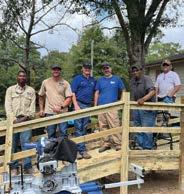



























Each year around this time our home becomes a hectic place filled with cleaning and preparing for our family members’ eagerly anticipated arrival. In addition to our adult sons, daughters-in-law, and young grandchildren, the cousins from all around the country make the annual Thanksgiving trip to Meridian. This year we expect relatives from New York, St. Louis, Dallas, Houston, Hattiesburg, Tupelo, Clinton, Gulfport, Birmingham, and Atlanta. It is a fun time filled with remembrances of some who have gone to be with our Lord, excitement as we meet the new additions, and celebration as we laugh and listen to what is happening in their lives.
Meals will be planned and shared starting the Wednesday evening before Thanksgiving and going through the last day anyone is here. As the last relative heads home from the Thanksgiving feast, we will put those things away and begin the preparations for Christmas. While the crowd is smaller at Christmas, we still pour our energy into choosing the right gifts and planning meals we will enjoy with our immediate family members. So why put so much planning into our holidays?
Planning ensures we won’t have disappointments or distractions interfering with the things we enjoy doing with our family members over the holidays. Plans for the simple things, like where everyone will sleep and what will be served at each meal, ensure all our visitors enjoy their stay as much as we enjoy having them.
Here at East Mississippi Electric Power Association, we also understand the importance of planning. Planning provides direction in the facilities we build to meet our members’ electrical load requirements, both individually and collectively along the 5,700 miles of distribution lines we maintain. Distribution system planning is a long-term process. It requires developing electrical load projections 10 to 20 years into the future. These long-range plans are then broken down into construction work plans of about two to three years. The daily








planning work that goes into making sure the lines are adequate ensures the holiday loads will be reliable and a ordable to you, our members.
The addition of East Mississippi Connect increased our need for planning to new levels. Our team has been steadily learning the fiber business, continuing to build new services to homes and installing equipment to serve member needs. Over 3,860 miles of fiber construction is complete with more than 15,000 members enjoying broadband speeds only previously dreamed of in rural areas. You are making this endeavor a success and we thank you for the support.
Throughout the holidays we will have dedicated employees ready to respond on a moment’s notice should the need arise. Many times, we have worked Thanksgiving, Christmas, and New Year’s Day to restore service when storms or accidents happen. Our workforce planning process ensures we have educated and well-trained employees that not only design, build, and maintain the electric and fiber systems but can restore service when it is interrupted. I’ve said many times that the cooperative family life isn’t just a job; it is a calling. Much like firemen and police o cers, our employees run towards trouble when it happens, and their entire family supports the e ort.
So, as you enjoy time with your family and friends this Thanksgiving, Christmas and New Year’s holiday, know that EMEPA and our team are well prepared and ready to provide the services needed to empower your lives and maintain the pathways to community success.

by Randy Carroll


















Electric cooperatives employ a variety of methods to reduce the likelihood of power outages — from regular tree trimming, to equipment maintenance and repairs, to local grid updates. But outages do occur, and when they do, co-ops are ready to respond.
Another way co-ops prepare for major outages and disasters is through mutual aid, which is a collaborative approach to emergency planning. The mutual aid model allows electric co-ops to help each other out during times of need. This approach permits co-ops to “borrow” restoration workers from other co-ops, thereby increasing the workforce response to areas impacted by a major outage event. It’s essentially about neighbors helping neighbors, even when those neighbors are fellow co-ops located hundreds of miles away.
Electric co-ops operate according to seven principles, and principles six and seven, Cooperation among Cooperatives and Concern for Community, are directly connected to the mutual aid model.




assist with coordination between states, helping to ensure the necessary personnel and equipment, which are the key ingredients of the mutual aid recipe. These e orts require e ective logistics management and experts who fully understand resource allocation and have the know-how to respond under pressure.

During major outage events, a variety of equipment is necessary to complete repairs, including bucket trucks and other specialized vehicles, utility poles, transformers, and wires. Skilled lineworkers, tree trimmers, damage assessors, and other key personnel are also often shared among co-ops. These experts provide critical skills and manpower to speed up the restoration process.
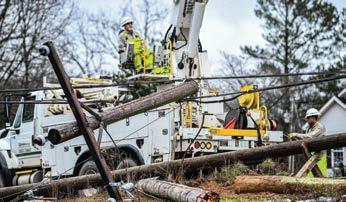
The goal of mutual aid is to restore power as quickly and safely as possible after a major outage event. By sharing resources, co-ops can significantly enhance their response capabilities.
Electric co-ops were formed to provide reliable electric service to their members at the lowest reasonable cost, and mutual aid has been a fundamental part of our DNA since co-ops were formed. The concept of mutual aid originated with the rural electrification e orts in the 1930s. From the very beginning, electric co-ops relied on each other to assist in times of need, and mutual aid provides an essential safety net in times of crisis.
Mutual aid ultimately benefits co-ops’ consumer-members. During major outage events, co-ops can increase their workforce and respond more quickly, leading to shorter outage times for members. Disaster response and mutual aid is managed by electric co-ops, as well as co-ops’ statewide organizations. The statewide organizations
experts provide critical skills
standards, line crews from any
Because the national network of transmission and distribution infrastructure owned by electric co-ops has been built to federal standards, line crews from any electric co-op in the U.S. can arrive on the scene ready to provide emergency support and secure in their knowledge of the system’s engineering.
Today, mutual aid continues to be a vital part of how electric co-ops operate and serve members of their local communities. The goal of mutual aid is to restore power as quickly and safely as possible after a major outage event. By sharing resources, co-ops can significantly enhance their response capabilities. In essence, mutual aid embodies the sixth cooperative principle of “Cooperation Among Cooperatives” and ensures that members receive reliable electricity even in the face of major challenges.
Jennah Denney writes on consumer and cooperative a airs for the National Rural Electric Cooperative Association.














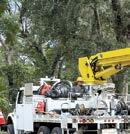

When Hurricane Helene unleashed its fury as a Category 4 storm, the devastation left millions in the dark. In response, EMEPA swiftly sent 15 crew members and support sta on Sept. 27 to assist in restoring power, joining forces with Talquin Electric Cooperative in Quincy, Florida.
By Sept. 29, after successfully helping Talquin Electric complete its restoration e orts, the EMEPA team pressed further east to assist Central Florida Electric Cooperative in Chiefland, Florida. The mission: to bring relief to those who were still reeling from the storm’s impact.
Hurricane Helene’s aftermath was staggering, leaving 1.25 million cooperative members without power across the southeastern U.S. In total, more than 6,400 personnel from over a dozen states answered the call for help. Mississippi’s electric cooperatives contributed 280 linemen, right-of-way crews, and support sta , forming part of this national mutual aid e ort.
Following the return of crews from the Helene response, a second rotation of 22 crew members were dispatched to assist Glades Electric Cooperative in central Florida. They will help restore power in the aftermath of Major Hurricane Milton, which made landfall on October 9 near Tampa, leaving widespread damage and power outages in its wake.
EMEPA’s dedication to bringing power and hope continues, as crews remain on the front lines, providing critical support to communities a ected by these devastating storms.

































Seamless streaming access

Stress-free online shopping
Stay connected with family













The holiday season is here, and fast and reliable internet is at the top of everyone’s wish list. Whether you’re streaming holiday classics, hunting for the best deals on gifts or hosting virtual get-togethers with family and friends, East MS Connect delivers the fast, dependable internet you need.


With East MS Connect’s high-speed internet, your holiday entertainment is just a click away. While we don’t provide streaming services directly, our StreamNow platform helps you find the perfect streaming provider to fit your needs. Whether you’re planning a family movie marathon or catching up on festive shows, enjoy HD streaming without bu ering or interruptions. StreamNow makes it easy to discover and access all your favorite content in one convenient place.
Shopping online is stress-free with East MS Connect. Our fiber-fast internet ensures you can browse and purchase without worrying about slow connections or delays. Whether you’re tracking down the best Black Friday deals or ordering last-minute gifts, our reliable internet lets you shop confidently. And with East MS Connect, you never have to worry about hidden fees or tricky contracts—just straightforward, honest service you can trust.
The holidays are all about connecting with loved ones, and East MS Connect makes it simple. If you can’t gather in person, our high-speed internet keeps you close through crystal-clear video calls and virtual gatherings. Stay connected with family and friends no matter the distance, with unlimited data and no disruptions. Plus, with our no-contract service, you can focus on making memories instead of worrying about your connection.






tips
As your trusted local provider, we believe in transparency—no hidden fees, no contracts and no surprise price increases. Plus, with our StreamNow service, it’s never been easier to enjoy your favorite content. This holiday season, we’re grateful for the opportunity to serve our communities and help you enjoy what matters most.
Manage your devices with the EMC Wi-Fi app
As you welcome guests and new devices into your home this holiday season, the EMC Wi-Fi app makes managing your home network a breeze. Easily monitor connected devices, troubleshoot issues and even set parental controls—all from your smartphone. With East MS Connect, your home internet will run smoothly, keeping everyone connected and ensuring your network can handle all the extra activity.
Along with the holiday cheer, online scams tend to rise during this season. Protect yourself with basic cybersecurity practices, like using strong passwords and avoiding suspicious emails. East MS Connect includes built-in, network-level protection to keep your home network and personal information safe. We help ensure your online shopping and browsing are secure so that you can focus on enjoying the season with peace of mind.
This holiday season, East MS Connect is here to make life easier. Whether you’re streaming your favorite shows, shopping online or staying in touch with loved ones, our reliable high-speed internet and StreamNow services will keep everything running smoothly. As your local provider, we’re committed to transparent pricing with no hidden fees and no contracts.








































On Sept. 27, 2024, Magnolia Electric Power sent 13 linemen to Florida to assist in restoration e orts from Hurricane Helene.
The MEP linemen drove to Talquin Electric Cooperative, located in Quincy, Florida, and worked with them for the first few days on restoration e orts. Then two days later, they traveled to Central Florida Electric Cooperative, headquartered in Chiefland, Florida, to aid in their power restoration e orts.

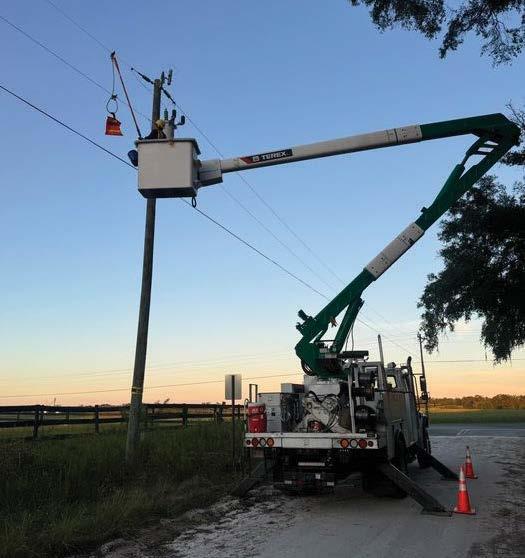
The Magnolia Electric Power linemen in Florida were Stacy McCaskill, Dusty Rollinson, Andrew Wood, Jason Mallette, Adam Sandifer, Colby Fortenberry, Daniel Hollingsworth, Sam Mabile, Bo Allen, Wes Burns, Jonathon McCaskill, Jett Calcote, and Nyles Branch.
By working with other electric cooperatives, MEP actively demonstrated Cooperative Principle No. 6, which is Cooperation Among Cooperatives.
We also want to thank all our members who posted words of support on our Facebook account for our linemen to read. The kind words of support mean so much.





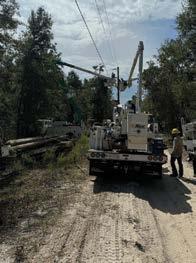
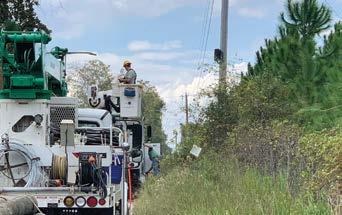






There’s nothing quite like the warmth of a chilly Mississippi night filled with good food, great company, and a cause that stirs the heart. Each January, Shu e to the Chefs invites locals to gather at McComb’s historic mill for an unforgettable evening. Benefiting St. Andrew’s Mission, the event has become a beloved tradition that pairs mouthwatering cuisine with a greater purpose.
Attendees are treated to tastings from the area’s top professional and amateur chefs, enjoying everything from Southern comfort dishes to more adventurous fare. Wine and beer flow, laughter fills the air, and guests mingle at this marquee event that celebrates not only the culinary arts but also the spirit of giving.
“Shu e to the Chefs has become somewhat of an institution within our community. Folks have come to love the event so dearly, and rightly so, as it’s not only a prime night of socializing and networking but a philanthropic life-source for the great work that we are committed to at St. Andrew’s Mission,” said Brandon Andrews, a St. Andrew’s Mission board member and chairperson for the 2025 event.
The mission’s reach extends far beyond McComb, supporting initiatives like free medical clinics for the uninsured in Brookhaven and McComb, a food pantry for seniors and adults with disabilities, and S.A.M.’s Diner, a soup kitchen o ering hot meals to those in need. The mission’s six thrift stores located in McComb, Brookhaven, Natchez, Vidalia, Ridgeland, and Vicksburg, and the McComb Business Mill further strengthen the community by providing both a ordable goods and space for small businesses to grow.
For Andrews, the 2025 Shu e holds special meaning, drawing inspiration from Fred Rogers’ famous words: “When I was a boy and I would see scary things in the news, my mother would say to me, ‘Look for the helpers. You will always find people who are helping.'”
“I believe that is truly what we are doing. We are being helpers, and what a true blessing it is to do so for our great community and its surrounding areas,” Andrews said.









Co-chairperson for Shu e 2025, Catherine Sanders, echoed the sentiment.
“Shu e to the Chefs is a beautiful reflection of our community coming together. It’s not just about the incredible food — it’s about the sense of unity and generosity that fills the room,” Sanders said.
“We’re able to do so much good because of the people who attend and support the mission. I’m honored to help lead an event that truly makes a di erence in so many lives.”
While Shu e to the Chefs is about savoring the rich flavors of the area, it’s also about a shared commitment to lifting lives. The event has become a beacon of hope, reminding all who attend that through community and compassion, we have the power to make a lasting impact. There’s nothing more Southern than that — good food, good friends, and a good cause, all working together to serve something greater than ourselves.
The event is Jan. 23.
For more information, search “Shu e to the Chefs” on Facebook or visit Facebook.com/Shu etotheChefs. The Magnolia Electric Power business o ce will be closed Thursday, Nov. 28, and Friday, Nov. 29, for Thanksgiving. MEP Linemen will be on call. To report a power outage, call 601-684-4011 or use the SmartHub app.







































Tylertown’s long-running holiday light show marks its 26th season this year at the town’s 40-acre park, located on the east bank of Magee’s Creek
While the park’s walking trails remain open for health-conscious residents who enjoy the benefits of walking the park’s trails, the park closed to vehicular tra c on Oct. 1 to allow workers to transport, erect, and set up thousands of Christmas light displays people have come to expect over the holiday season.
It takes the crew about five to six weeks to transform the park into the holiday light show known as “gazillion lights.”
Prior to Christmas in the Park, the committee hosts a Christmas Craft Show and Bazaar on Nov. 22 and 23, at the Southwest Events Center. Visitors attending the show will get an early look at the lights riding a custom designed trailer traveling the park at 15 to 20-minute intervals. The preview rides are available for $5 for adults, while children under 12 ride free.
Then, less than a week later, Christmas in the Park opens on Thanksgiving Eve, Nov. 27 from 6 p.m. to 9 p.m. Admission for the one-hour walking tour is $5 per adult, while tickets for children 12 and under cost $2. Visitors should enter at the Southwest Events Center entrance on Highway 48 East.
The drive through tours begin at dusk Thanksgiving night, Nov. 28. Following Thanksgiving night, the vehicle tours continue until 8:30 p.m. through New Year’s Eve. Admission is $5 for passenger vehicles, $10 for commercial vans, and $20 for buses. Entrance for the drivethrough tours is on Old Highway 98 East at the Magee’s Creek Bridge.
The well-known holiday season lighted tour, Christmas in the Park, attracts thousands of visitors to this small Southwest Mississippi town of just under 2,000 residents during the Thanksgiving to New Year’s Eve period.
The lighted park has been featured on area television stations, in newspapers and magazine stories, and on web sites, including being








named as one of the state’s “Must See” Christmas attractions and mentioned in the Top 10 Holiday Displays in Mississippi.
The community-supported event is operated by a volunteer committee as an arm of the Walthall Chamber of Commerce.
From displays such as Toyland, the 12 Days of Christmas, Noah’s Ark, Santa’s Sleigh and Reindeer, a Cajun Village, Gingerbread House, Cinderella, Three Wise Men, the Manger Scene, Santa’s Choo-Choo, animated stage musicians and dancers and dozens more, Holmes Water Park’s over 40 acres are transformed into a splash of color and lights, enjoyed by everyone from children to adults, and even the pets that accompany many families on their nightly driving tours.
Many displays are donated by individuals who, in some cases, add to their decorations periodically. Most have a special meaning to the families and individuals who donate them to the park. Candy Land and the Gingerbread House were placed in the park by grandparents to honor their grandchildren. Now, almost 30 years later, those grandchildren are bringing their children to the park to see those displays which have been refurbished and updated over the years and the many new displays added.
Replicas of classic cars, Santa flying an airplane, golfers, fishermen, and hunters all reflect the hobbies of those placing displays.
Old McDonald’s Farm was an early display placed by the McDonald family, operators of the farm and tree plantation near China Grove. The Cajun Village was donated by a woman who moved from Louisiana to Walthall County, celebrating her heritage. The Cajun Village is popular with other transplants who have moved here over the years from the state that adjoins Walthall County’s southern border.
Closer to Christmas, the park committee hosts a second craft event, Tylertown’s Country Christmas Festival and Craft Show on Dec. 13 from. 10:30 a.m. to 5:30 p.m. 10:30 a.m. and on Dec. 14 from 9 a.m. to 2 p.m. at the Agri-Heritage Building, downtown.
For more information, call 601-876-2680.






Workers will soon start to erect the lights and colorful displays that encompass the 40-acre Holmes Water Park in advance of the opening of Christmas in the Park in Tylertown on Thanksgiving Eve.

Craft vendor spaces are sold out for the event.
In conjunction with Christmas in the Park, a Christmas Craft Show and Bazaar is held Nov. 22 and 23 from 3 p.m. to 9 p.m. at the Southwest Events Center.
Another craft show before Christmas is Tylertown’s Country/Christmas Craft Show on Dec. 13 from 10:30 a.m. to 5:30 p.m. and on Dec. 14 from 8 a.m. to 2 p.m. at the Agri-Heritage building. A couple of vendor spaces are left for the shows on Dec. 13 and 14.
The two shows have become musts for holiday buyers and vendors alike as many of the gifts are handmade, one-of-a-kind items.


There are many gift ideas available, including custom jewelry, book marks, crotchet, metal work, whimsical art, paintings, a variety of woodcrafts, stained glass, engraved items, jellies and preserves from products native to the area, baked goods, and candy.


































As November kicks o , it’s hard to believe we’ll soon be gathering with family and friends to celebrate the holiday season. This festive time of year brings joy and warmth, but as the weather gets cooler and we spend more time indoors, the holidays can also bring increased energy use and a higher risk of electrical and fire hazards.
As your local electric cooperative, our team at Monroe County Electric cares about your well-being. This month, I’d like to share a few practical tips to help you stay safe and e cient during the holiday season.
My family truly enjoys decorating our home for the holidays. Before we deck the halls, I always check electrical cords and light strands to make sure they aren’t frayed or damaged. This gives us peace of mind, knowing our holiday lights are ready to safely brighten our home. I also double check the lights we use outside to make sure they’re rated for outdoor use.
Like many households, we also enjoy holiday-scented candles. While festive, candles can create fire hazards and should never be left unattended. One of the best and easiest ways to safeguard your home is to test smoke alarms often. I test mine on the first of each month, so it’s easy to remember. Testing smoke alarms only takes a few seconds and could save lives, so make it a habit.









There’s no denying one of the best parts of the holiday season is
There’s no denying one of the best parts of the holiday season is the food—not just the meals but the time we spend together in the kitchen. There are many ways to save in the heart of your home, but one of the best approaches is to cook with smaller countertop appliances, such as air fryers, slow cookers, and toaster ovens. These handy appliances consume a fraction of the energy used to heat the oven, creating the perfect recipe for mealtime and energy savings.
I hope you will implement some of these energy-saving and safety tips into your holiday plans. For additional advice, visit our website at www.monroecountyelectric.com. We’re here to help you with safety and savings year-round.
From your friends at Monroe County Electric, we hope your holiday season is merry and bright.



Spending more time indoors with a few more guests in the home can really impact home energy use. By taking a few small steps to save energy during the holiday season, you can lower your bills. I like to remind my family members to mind the thermostat. Since heating and cooling makes up the majority of home energy consumption, the thermostat is one of the best places for savings. Lower it a few degrees, especially when you have family or friends stopping by. Good company brings additional warmth to your home.
stopping by. Good company brings additional warmth to your home.

Your family can also save energy by decorating with LED holiday lights. LEDs are the most energy e cient lighting options available, and they last much longer than traditional bulbs.









































How can smart home technology help me lower my power bill?
by Miranda Boutelle
When upgrading to smart technology at home, consider the purchase cost as well as long-term savings. For example, you may pay a little more for a product with the latest technology, but it could result in significant savings each year and over the lifetime of the appliance.
Here are some smart devices that will take the work out of saving energy.
Smart thermostats save energy by automatically adjusting your heating or cooling system. For example, you can save as much as 10% a year on heating and cooling costs by adjusting your thermostat 7 to 10

Smart technology can make it easier to save energy by simplifying or automating tasks. It can also optimize energy use to reduce waste and improve e ciency.
degrees from its normal setting for eight hours a day, according to the Department of Energy (DOE).
You can program a smart thermostat to change the temperature when you are asleep or away, or use a smartphone app to adjust your thermostat settings. Some models use artificial intelligence to maximize e ciency by learning your patterns and preferences. Prices range from $80 to $250, depending on features. Smart thermostats do not work with all heating and cooling systems, so check compatibility before you buy.

Your water heater can also be controlled for energy savings. Installing a timer on your electric water heater can save 5% to 12% of the energy it uses by turning it o at night and when you don’t need to use hot water, according to the DOE.
If you are already planning to replace your electric storage water heater with a heat pump water heater, consider a model equipped with smart technology features, including Wi-Fi capabilities for controlling it remotely or during peak demand times, viewing the amount of hot water available and tracking energy use. There are a variety of modes, including vacation, e ciency and high demand, which produces more hot water. Some models can notify you or shut o if a leak is detected. Depending on the manufacturer and size of the unit, a smart heat pump water heater may only cost a few hundred dollars more than a standard heat pump water heater.
Upgrading to smart home technologies can make it easy to use less energy at home. Choose options that make the most sense for your lifestyle to optimize savings.

Smart lighting gives you the power to control lights in your home remotely or set a lighting schedule that fits your lifestyle. This can be beneficial for energy savings and provide home security benefits. If you or other members of your household are notorious for leaving lights on, smart lighting can help. Numerous features are available, including dimmable bulbs and color-changing e ects.
Smart light switches are another budget-friendly way to control lighting. They’re priced from about $10 to $50. Smart switches with dimmable options are available and can also control ceiling fans. Some have occupancy sensors that turn lights o when no movement is detected in a room.
A smart plug fits into any outlet to control whatever is plugged into it. Set them to automatically turn o and on or control them using a smartphone app. Prices range from $8 to $25.


A wide variety of smart shades, curtains, and blinds are available, including styles with integrated controls. You can also add smart controls to your existing blinds or curtains. Both options allow you to adjust the tilt of blinds and open or close curtains. Set a schedule, control them remotely or use a voice command paired with a voice assistant, such as Alexa or Google Home. This allows you to reduce cooling needs in the summer and heating needs in the winter. Smart controls start at around $70. To save the most energy, prioritize windows with the most incoming light.
Upgrading to smart home technologies can make it easy to use less energy at home. Choose options that make the most sense for your lifestyle to optimize savings.






















by Scott Flood


You might be surprised to learn that your local electric cooperative doesn’t generate the electricity you use in your home or business. In most cases, your co-op does not own a power plant but instead purchases electricity from an outside source, then routes the power to your community.
For more than 800 electric cooperatives across the country, the source for electricity is a di erent kind of cooperative. Referred to as “G&Ts,” these Generation & Transmission cooperatives exist to help electric co-ops serve their members as reliably and a ordably as possible. Their only members are local electric co-ops, so G&Ts are actually cooperatives that serve — you guessed it — cooperatives.
Across the nation, 64 G&T cooperatives provide access to wholesale (at-cost) power at a better price than each of their member co-ops could obtain on their own. Most G&Ts go beyond the delivery of power to provide sophisticated business resources that would normally be out of reach for local co-ops.
Like your local co-op, G&Ts are not-for-profit organizations that exist to serve the needs of their members. G&Ts generally serve all the co-ops in a specific geographic area.
Cooperative Energy is a G&T in Mississippi. The Tennessee Valley Authority is a public power entity that serves the G&T function in part of the state.
G&Ts employ a leadership team of experts in data, finance, engineering, economic development, environmental management and other important specialties that are essential for electric co-ops. The G&T operates behind the scenes to support the local co-op’s teams, and although G&Ts may be largely unseen, they operate with complete transparency.
G&Ts are best known as the source for at-cost electricity that is generated elsewhere, then delivered to your local co-op over high-voltage transmission lines. Your co-op uses distribution power lines and transformers to then deliver that electricity to your home or business.
Most G&Ts maintain their own power plants, while others purchase power for their members on the wholesale market. Some G&Ts manage a combination of native power generation and purchases. Because a G&T buys enough power to supply all of its member co-ops, it has the bargaining power to secure significantly lower prices than those co-ops could negotiate by themselves. Regardless of how they’re structured, G&Ts help keep your electric bill smaller.
Just as important is the work G&Ts perform in planning. The nation’s energy landscape is changing rapidly. G&Ts constantly work with local co-op sta to study and forecast power needs. They consider how growing communities might a ect the demand for







electricity in the future and work closely with local co-ops when power reliability is challenged, such as times when electricity demand outpaces supply or after a major weather event.
In addition to obtaining the electricity local co-ops need, G&Ts improve and maintain the reliability of the infrastructure co-ops and their communities depend upon. By working with local co-op sta to upgrade transmission lines and deploy substations, they make sure the power will be there for members, like you, when you need it. G&Ts also work closely with government agencies that monitor and manage the nation’s electric grid.
So, while your co-op may not own the power plant that generates the electricity you use every day, it’s part of an even bigger not-forprofit cooperative whose mission is to make your service even more reliable and a ordable. As the power behind your power, just like your electric co-op, G&T cooperatives exist to serve you.
For more than four decades, business writer Scott Flood has worked with electric cooperatives to build knowledge of energy-related issues.



















For more information about Today in Mississippi, contact Sarah Brooke Bishop or Marlin Williams at 662-234-6331.



North East Mississippi Electric Power Association’s annual meeting will be held on Dec. 14 at 1 p.m. in the NEMEPA auditorium at 1389 Cooperative Way.
At the annual meeting, Keith Hayward, general manager/CEO, will give an update on the association and NE SPARC. The election results from the election of the Board of Directors will also be announced. You can win a prize for attending the meeting. Winners will be announced that day.


You can participate in our board of directors’ election in a new way this year. We have partnered with Survey and Ballot Systems to o er an electronic link to cast an online ballot or proxy. These links will be sent to all email accounts on file. We will still o er a paper ballot and proxy. However, due to delays with the USPS we are encouraging members to use the online form. The ballot and proxy are sent out along with your o cial meeting notice approximately 30 days before the annual meeting. All ballots returned will be eligible for a prize.
Playback from the meeting will be available for viewing the following week, so if you can’t make it in person, check our website or social media to learn how to watch.

The Tennessee Valley Authority (TVA), who North East Mississippi Electric Power Association purchases our power from, approved a 5.25% wholesale rate increase that took e ect on Oct. 1. North East members have been a ected by this increase.
Since the population in the region is growing at three times the national average, TVA says there is a need for new generation of power. This rate increase will be used to fund ongoing construction and energy development to address that need for TVA.
“We know an increase can be challenging for our members. We expect this will be the last rate increase TVA passes for the next four years,” said Keith Hayward, CEO/general manager North East Power.
The average member of North East Power uses approximately 1250 kWh per month. This means the average member should expect an increase of 4.5% or roughly 28 cents per day. This is $8.65 per month added to their bill, which members should have seen on the October statement.
“We are also seeing tremendous growth in our service territory. As we continue to battle increases in material and construction expenses, the employees at North East Power strive to provide safe, reliable, value added energy to our members. We appreciate all of our members and hope they will understand the increase is necessary to ensure a reliable source of energy,” said Hayward.








Briana Brown
Ceresa Caudill




Area schoolteachers were recently awarded Bright Ideas grants from North East Mississippi Electric Power Association and NE SPARC. Ten local educators were selected after submitting an online application and being judged by an independent selection process. These educators secured funds for their creative and innovative classroom projects.
Teachers from Lafayette, Oxford, Pontotoc, and Union County school districts received the nearly $10,000 awarded through the Bright Ideas program that will enrich the education of hundreds of children.
“The Bright Ideas grant program helps us live out one of our core cooperative principles— concern for community. We deeply value the dedication and hard work of our local educators, and this grant is a small way for us to show our appreciation,” said Sarah Brooke Bishop, communications and marketing manager for NEMEPA, NE SPARC. “The best part is surprising the winning teachers and schools in person with the award — it’s always such a fun and rewarding moment.”
This is the third year NEMEPA and NE SPARC distributed grants of up to $500 to public school teachers teaching K through 12th grade in their service territory. All classroom subjects are eligible for funding, including but not limited to STEM, language arts, and social studies. Teachers with a bright idea simply submit an online form when applications are open.

Robin Hess
Oxford Intermediate School
Oxford Intermediate School
Rachel Chrestman
D.T. Cox Elementary School
Brandi Cooper
West Union Attendance Center
Mimi Shaw and Laurie Beth Ellis
Della Davidson Elementary

Lafayette Elementary School
Margo Parker
Lafayette Elementary School
April Phillips
South Pontotoc Elementary School
Mary Beth Smith
Lafayette Middle School
Misty Vineyard
D.T. Cox Elementary School



In the wake of Hurricane Helene’s devastating impact on central Florida, North East Mississippi Electric Power Association crews were among the many who answered the call to assist in restoring power to the a ected areas. Upholding one of the Seven Cooperative Principles — Cooperation Among Cooperatives — NEMEPA proudly sent our dedicated linemen to support restoration e orts.
A total of 280 linemen and servicemen from across Mississippi were deployed to Florida to help communities facing extensive damage and power outages. These dedicated workers are giving their all, laboring under extreme conditions and working long hours to help restore essential services to those in need.
“We’re proud that our guys always step up and help,” said Keith Hayward, North East Power CEO/general manager. “This is what the cooperative spirit is all about — supporting one another in times of crisis.”
With their skill and perseverance, these crews not only restored power but also brought hope and relief to those impacted by Hurricane Helene.
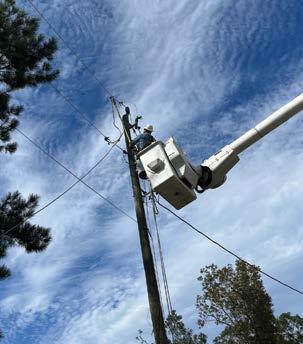
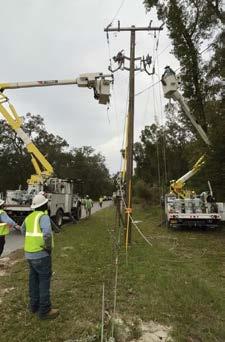
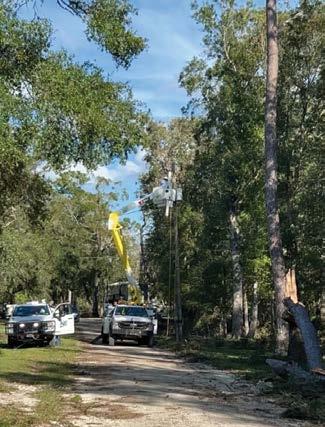























































Tired of glossy ads and commercials from national cable giants promising unbeatable deals? Did you know that NE SPARC has a local, superior option for fiber internet? Read on to discover four reasons why local residents prefer NE SPARC.
1 North Mississippi residents want reliable, responsive customer service
Our top priority is providing superior customer service and support. At NE SPARC, you’ll experience the personal touch of our friendly and responsive agents. Unlike the big companies, we pride ourselves on quick, friendly support.
When you contact us, you’ll speak to someone from your local community who truly cares.
3 Your dollars make our community a better place to live
Like other local businesses and institutions, NE SPARC enriches and uplifts our community as a whole. When you shop locally for internet, we can engage with our local community by sponsoring local events and non-profits.
Our team loves to give back! Many of our team members participate in volunteer e orts to help meet critical local needs and organize and participate in town and regional events and celebrations. NE SPARC also partners with North East Power to provide grants to local teachers who have innovative ideas for their classrooms.
2
Local construction crews care for our community
Our deep local roots mean that NE SPARC takes a more thoughtful and gentle approach to constructing and maintaining internet infrastructure. We treat our community with the utmost care because we live here too.
Since we are proudly local, we will always treat the Oxford area with greater care. From stopping to chat with neighbors who come outside to cleaning up after we’re done, our crews are committed to our town. And when we make a mistake, we’re quick to own it and make it right. For any construction-related questions, feel free to contact our o ce at 662-238-3159.
4 Local fiber means state-of-the-art technology
Shopping locally doesn’t mean sacrificing your internet experience. On the contrary, fiber is the pinnacle of internet technology, o ering unmatched reliability and speeds that surpass those of national cable and wireless companies. NE SPARC’s fiber network utilizes sophisticated materials to deliver data at nearly the speed of light, providing download speeds that can exceed 2 gigabytes per second.
Only fiber’s state-of-the-art technology enables robust upload speeds and “symmetrical internet,” which is crucial to clear, distortion-free video conference calling, telehealth consultations, online gaming, and uploading videos and other large files without slowing down or overwhelming the internet connection.
These are just a few ways NE SPARC’s advanced fiber network enhances our community and your internet experience. Find out how you can get NE SPARC at your home or business by visiting www.nesparc.com.


















We at Northcentral just wrapped up our celebration of National Cooperative Month. Events included a Membership Appreciation Day as well as our 74th Annual Membership meeting.
We also participated in one of the more important cooperative principles, cooperation among cooperatives. September and October saw the southeast United States get pummeled by two large hurricanes. The damage from Helene and Milton caused power outages to well over a million electric cooperative consumers. Crews from all over the country, and some international, were prepared to travel as the storms devastated southeast communities. Northcentral’s multiple crews and equipment spent more than three weeks away from home restoring power. This cooperation leads to quicker restoration and is something somewhat unique to our industry.
As we move into November, we remember those that served in our armed services defending our country. Armistice Day was created at the conclusion of World War I to honor those who
Thank you, veterans. Stay safe.










served and created an opportunity to resume peaceful relations with others. After what had been deemed the most destructive conflict to date, the name was changed to Veterans Day to honor those from all conflicts. Nov. 11 is indeed a special day. Let’s make sure we honor those on Nov. 11, as well as on other days, with the respect and reverence they have earned and deserve.
by Kevin Doddridge General Manager/CEO



We o er our heartfelt gratitude to all of those who have served our country.
Thanks to Northcentral’s and Northcentral Connect’s veterans:
DAVID BRANSON
United States Marine Corps
JACOB DANIEL
United States Marine Corps
ZAC DIAS
United States Marine Corps Reserve
BOBBY JOHNSON
United States Army
CLIFF LAUDERDALE
United States Army
PETE NELSON
United States Army Reserve
DONTRELL STROMAN
United States Army









We will be closed Nov. 28 and 29. A dispatcher will be on duty.



















Northwest Mississippi Community College recently announced a new scholarship endowment established by Northcentral Electric Cooperative. The James E. “Jimmy” Woods Endowed Scholarship honors Woods, who served as board attorney for Northcentral for 50 years before his retirement in 2023. In addition to his private practice and service to Northcentral, Woods represented three municipalities and two school districts during his career.
This is the fifth scholarship endowed by Northcentral Electric Cooperative at Northwest. “Honoring those who served Northcentral and its members is a lasting recognition of their impact on our



community,” Northcentral General Manager and CEO Kevin Doddridge said. “Supporting education and our great community college system is not only a commitment to our cooperative principals, but also to the future workforce of our region.”
The criteria for this scholarship is that the student must be a member or immediate family of a Northcentral Electric Cooperative member. Information about this scholarship and the many other endowed scholarships at Northwest can be found under the “Financial Aid” section of their website. If you’d like to learn more about Northwest, or contribute to the foundation, please visit northwestms.edu/foundation.


















by Michael Bellipanni






Northcentral Electric Cooperative’s fiber-to-the-home buildout continues, having passed by more than 23,000 homes and businesses so far. Internet services that were once either unavailable or inadequate are being delivered by our subsidiary, Northcentral Connect.
Whether your purchasing decisions are based on price, service, reliability, or you just prefer doing business with people you know and trust, Northcentral Connect checks all the boxes. We’re eager to provide you with the internet connectivity that has become almost as essential as the power we’ve been bringing to our communities for 74 years. Check us out if you haven’t already!
At Northcentral, we’re committed to bring you innovative solutions to support the things you value. That’s what drives Northcentral Connect to be more than just a telecom provider. You may be aware of our di erent service plans, but let us introduce you to the other solutions that we hope set us apart from the rest.
To many, a traditional home phone service is still important. Those that work from home or live in a spotty cell phone coverage area need a reliable means of communication. Some want the peace of mind for security or to be able to reach out in the case of an emergency. With any of our service plans, Northcentral Connect o ers a Voice over Internet Protocol, or VoIP, phone service for just under $20 a month, before mandatory taxes and fees. We can even assist in keeping your same phone number!








Northcentral Electric is committed to providing reliable power, but we all know that mother nature sometimes has other plans. For an additional $17.95 per month, Northcentral Connect o ers battery backup to keep your wireless devices online for 24 hours in the event of an extended power outage. There’s also an 8-hour backup for the more budget-conscious subscribers.
Don’t bu er in the basement or on the back porch! Let our experienced technicians take a survey of the Wi-Fi signal in your home and ensure that you have true whole-home fiber coverage. We can install devices to extend your network to every room and even outdoors to enhance your Northcentral Connect experience.












Deloitte’s 2023 Connected Consumer Survey revealed that the average American household has 21 connected devices in the home. Each of the devices on your home network is competing for bandwidth. ExperienceIQ™, o ered by Northcentral Connect, is a solution to control your home network, prioritizing which devices get optimum tra c. You can even set schedules to control when they are allowed online. This is great for subscribers that want to ensure connectivity during video conferences, data transfers, or gaming. ExperienceIQ’s™ Safe Search feature blocks harmful or o ensive content in search engines. There are also content restriction features that allow you to better control what content is seen or heard on your home network.
The internet can be a dangerous place, and it can be particularly scary when your kids are online. As adults, we’re conditioned to guard our personal information and online activity. The reality with our children is that guardrails need to be in place well into their teenage years.
Bark is a subscription-based parental control app that currently covers over 7.1 million children worldwide. The app provides ongoing content monitoring of your child’s online activity, including texts, YouTube, and social media accounts. Once the app is downloaded to the child’s device, parents can customize filters and limits to provide supervision wherever the child goes.

When an event or threat is detected, like cyberbullying or a potential predator, parents get an alert so that they can intervene with their child. Every alert comes with professional advice and helpful resources on how to handle the situation. Bark monitors over 30 di erent applications for 45 di erent types of dangers. It even analyzes slang and emojis. Parents also get the benefit of location sharing and screen time controls for individual apps on kids’ devices.
ExperienceIQ™ or Bark can be added monthly to your Northcentral Connect service for $4.95 and $12.95 respectively. For the ultimate online protection at home and on the go, get both services with our Guardian Care package for just $14.95 per month.
To add or learn more about any of these enhancements for your Northcentral Connect experience, please visit our website at northcentralconnect.com, or call us at 662-932-3500.


























Pearl River Valley Electric Power Association held its Annual Meeting at its headquarters in Columbia on Sept. 28, 2024. One hundred and forty members were in attendance to conduct cooperative business, including the election of three directors to three-year terms. The following directors were elected:
District 3 • Hugh Gene Smith
District 6 • Matt Thomas
District 8 • Je Tinnon
Attendance and absentee prizes were awarded as a part of our celebration.





$1000 Prize
Luther T. Smith
$1000 KAREN ADAMS
$750 KAYE HORTON
$500 SEABORN LOTT
$100 AMY R. DOUGLAS
$100 SHERRIL L. ARCHER
$100 SOLOMON C. WHITE
$100 DOROTHY DEDEAUX
$100 ALAN L. CALHOUN
$100 ANNE ROBBINS
$100 MITCHELL A. NEW
$100 BILLY PARDUE
$100 KRISTIN L. RUSSELL
$100 MILDRED POLK

















$750 Prize
William Conner (for Etta Price)
$100 BETHEL CHURCH PARSONAGE





Ronald Montague
$100 EDDIE & PAULINE HILBURN
$100 LARRY PACE RAWLS
$100 SAMANTHA JENKINS
$100 RACHEL H. ROBBINS
$100 SHARON N. CLARK
$100 RANDY PRESCOTT
$100 REMY POIRRIER, III
$100 DEANNA M. COWART
$100 RANDY PARKMAN
$100 RICHARD N. COOLEY
$100 ROGER D. BROOME
$100 JAY D. STAATS
$100 WILLIAM KEARLEY
$100 DELMER L. CARROLL, SR.







$50 BEVERLY B. DAVIS
$50 DONALD DAUPHIN, JR.
$50 PAM CARTER
$50 VAN H. SMITH
$50 DIANE WILKS
$50 ANNE GARRETT BEMAN
$50 PAMELA BLUM
$50 GLORIA SMALLEY
$50 KEITH BARBER
$50 GENE OWENS
$50 FRED PACE
$50 LINDA SUMRALL
$50 ELSA C. VALDEZ
$50 FRANKLIN C. ANNERINO


$50 JESSE WASHINGTON
$50 GENE MOREE
$50 JUDITH ANN PRINE
$50 RAY MAGEE
$50 MELISSA A. WILLIAMSON
$50 RONNIE MCCARDLE
$50 KAREN M. JOHNSON
$50 IMOGENE HUFFMAN
$50 CECIL CHAMBLISS
$50 WILLIAM YAWN, JR.
$50 JARED WALDROP





Over the course of the last 12 years, Pearl River Valley Electric’s Round Up for Education program has helped over 2,000 students achieve higher education. This fall, 185 students throughout Pearl River Valley Electric’s 12-county service area will get a financial boost as they begin their school year. Each will receive a scholarship of $800 to help them attend state community colleges, thanks to the generous spirit and support of our members.
Pearl River Valley Electric’s Round Up for Education program is funded by members who round their bills up to the nearest dollar each month. Scholarships are available to members who participate in the program, as well as for their spouses or dependent children who are enrolled as freshmen this fall.
“The dedication of our members allows our electric cooperative to do amazing things,” said CEO/General Manager Matthew Ware. “Without their support of our Round Up for Education program, we wouldn’t be able to improve the lives of so many students.”
Since the Round Up program began in November 2012, nearly $2.5 million has been collected and deposited in an account overseen by the Pine Belt Foundation. In the program’s 12 years, 2,354 students have now received scholarships.

Scholarship recipients this year include 110 students attending Pearl River Community College, 31 at Mississippi Gulf Coast Community College, and 26 at Jones College. An additional 18 students are attending six other state community colleges. Overall, students came from 19 di erent high schools and homeschool programs.
“Sometimes the smallest gestures, like donating 50 cents a month, can make the biggest impact in our communities,” said Ware. “While it may not seem like your spare change can do much, when combined with the generosity of other Pearl River Valley Electric members, you can help change the life of a fellow member while also improving your local community. This program shows how working together can make a big di erence — and that is the cooperative way.”
Round Up for Education funds collected after Aug. 1 go toward next year’s scholarships. Applications for 2025 scholarships will be available beginning this month.





Total amount: $148,000
Each recipient receives: $800
Total recipients: 185
Copiah Lincoln Community College
Trevor Daniels CL
Joshua Robertson CL
East Central Community College
Brandi Bond Sum
Brette Loftin Sum
Isaac Shows Sum
Hinds Community College
Daniel Stringer WM
Nehemiah Taylor Jr. OG
Holmes Community College
Cade Clinton Sum
Rodney Stringer WM
Jones College
Chloe Arinder CA
Miranda Barefoot Sum
Chloe Bass Sum
Brodie Bass Sum
Mary Batson SHS
Charles Baylis Sum
Maggie Bennett Sum
Levi Blue WM
Cohen Bonner OG
Macie Boyd Sum
Sydney Clearman OG
Elizabeth Cook CHS
Tyler Cox OG
Taylor Dease CA
Wesley Findley PHS
Christopher Friend OG
Alana Holmes WM
Emma Hunt Sum
Kaleb Lewis OG
Ethan McNeil Sum
Emily McRaney Sum
Andrew Pearce FCAHS
Kaden Sistrunk EM
Madison Stewart OG
Sydney Turner OG
Avery Turner OG
Meridian Community College
Shannon Perryman PHS
Mississippi Gulf Coast Community College
Chaney Allison SHS
Caroline Batson SHS
Karlee Burnham D’Iberville High School
Catheryn Coleman SHS
Priya Collins SHS
Charles Eade FCAHS
Connor Hartfield OG
Marlena Haynes CHS
Madeline Hendry SHS
Anderson Hickman SHS
Brooklyn Hughes SHS
Meredith Matthews SHS
Stephen Maust Sum
Seniyah McDonald SHS
Jordyn Miller Home
Addison Miller Home
Kaylie Morrisette SHS
Cameron Norton SHS
Deakon Pearson SHS
Eva Pickering SHS
Kaylee Pickett SHS
Jay’Vion Ray SHS
Jacob Ross SHS
Anna Smith SHS
Bailey Sprowes SHS
Margaret Stevens OG
Britton Stringer Petal High School
Katherine Tutor FCAHS
Mackenna Velazquez SHS
Nadia Woodru SHS
Emma Sanders OG
Pearl River Community College
Ethan Altom PHS
Jadacae Armstrong FCAHS
Chloe Atkins PHS
Eli Aultman Sum
Kylee Backstrom PHS
Edriunna Barnes WM
Kindle Beach III PHS
Georgia Blackwell Sum
Tristan Bounds Sum
Anabelle Bounds OG
Daiyana Bradford FCAHS
Madison Breland FCAHS
Kishyra Breland SHS
Riley Bridges OG
Kody Broom Sum
Gavin Broome OG
Emma Brown Poplarville High School
Ashlyn Burkhalter Sum
Riley Burnside Lum
Ethan Cagle FCAHS
Kate Carlisle LCS
Jude Chance CHS
Konnor Daley PHS
Jabari Daniel CHS
Madison Davis WM
Allie Davis FCAHS
Lyric Delcambre Sum
Madison Dimitry SHS
Alicia Ducre WM
John Ellzey WM
Burton Eryn EM
Sara Evans OG
Bailey Expose CHS
McKenzie Fletcher Sum
Wiliam Fortenberry CA
Kaylee Foxworth FCAHS
Samantha Galloway Home
Nailah Gamble OG
Harley Garraway FCAHS
Jentry Gartman WM
Conner Graham OG
Arabella Guajardo FCAHS
Jacey Haire PHS
Kyara Hendricks EM
Kristofer Henry FCAHS
Ruby Hickman Home
Walker Hobgood CHS
Audrey Holder Home
Landon Holifield FCAHS
Abbie Honeycutt PHS
Amarrion Hopkins CHS
Jacob Howell PHS
Crystal Johnson EM
Dontez Keys Jr. Je Davis County High
Austin Lawler PHS
Kyleigh Lawler PHS
Montgomery Lee FCAHS
Braden Lee FCAHS
Wilson Leonard OG
Nickalas Lillis EM
Kyle Luker SHS
Kiersten Mallard OG
Alexas Mason PHS
Madison McCa rey OG
Joseph McCoy FCAHS
Alayah McGee OG
Je ery Mixon CA
Kerrigan Norton OG
Haven O’Neal Sum
McLin Paden EM
Kaleigh Parker WM
Nathan Parker SHS
Jaiden Parker OG
Brennan Parker FCAHS
Sarah Parker PHS
Zoe Pazos PHS
Michael Pearce PHS
Blaine Pigeon Lum
Lillian Pigott WM
Kyle Roberts FCAHS
Nicholas Rogers PHS
Raychel Rogers PHS
Cameron Rogers CA
Sydney Rowell New Hope Comm. Christian School
Sara Scarbourough WM
Daniel Scruggs Sum
David Scruggs III Sum
Houston Smith PHS
Barrett Smith PHS
Shay Smith SHS
Macy Spiers SHS
Colin Stoop PHS
Cason Strickland Home
Megan Stringer CA
Kelly Stubbs LCS
Kendyl Thornhill WM
Jonathan Thornhill Sum
Eden Thumm FCAHS
Kandace Upton CA
Jadyn Viniard Sum
Janiah Ward FCAHS
Jack Ware Home
Samuel Whittington PCS
Marlee Williamson WM
Cameron Woodward WM
Carl Yawn PHS
Luke Bailey Home
Tyler Ladner PHS
Ashlyn Anderson OG
Beau Bardwell SHS
Southwest Mississippi Community College
Devin Broom WM
Prestenbach Garrett WM
Holli Lee CHS
Carson Lee Sum
Hannah Martin Lawrence County
Jonathon Miller WM
Collin Mullins Lawrence County
Kaylee Stringer CHS

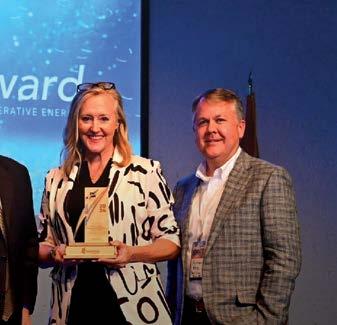



Recently, the Stone County Economic Development Partnership (SCEDP) was selected as the first-ever recipient of Cooperative Energy’s SPARK Award for their extraordinary work on the “Mississippi Miracle”: Anduril’s Road to Mississippi and the establishment of the Mississippi Solid Rocket Complex in Stone County.
The SPARK Award, which recognizes exceptional achievements in economic development within Cooperative Energy’s service territory, was awarded to SCEDP for their outstanding dedication, innovation, and impact in bringing Anduril Industries to Stone County. This prestigious honor celebrates the pivotal role that SCEDP played in securing the location and facilitating the expansion of Anduril’s solid rocket motor production facility — a project that has already begun to transform the local economy.
The “Mississippi Miracle” began when SCEDP leaders learned that a group of entrepreneurs was searching for a site to establish a solid rocket motor production facility in Mississippi. Through swift action and strategic collaboration with county stakeholders and utility partners, SCEDP successfully attracted the start-up company, Adranos at the time, to a vacated industrial site in McHenry, Mississippi. In September 2020, Adranos announced a $525,000 corporate investment and plans to create 20 new jobs on the 640-acre, seven-building complex formerly occupied by General Dynamics. Less than a year later, the company announced plans to increase testing operations, invest $1.35 million, and hire an additional 25 employees. The Stone County location was formally named the “Mississippi Solid Rocket Complex.”
In 2023, following the acquisition of Adranos by Anduril Industries, the Mississippi Solid Rocket Complex was poised for growth. To assist, the SCEDP purchased the property from the Stone County School District, making it only one of a few times in history that the sale of 16th-section land was allowed by the state
of Mississippi for the execution of a significant economic development project.

Recently, Anduril Industries announced a $75 million expansion of the Mississippi Solid Rocket Complex, which will increase the facility’s annual production capacity from 600 to over 6,000 tactical-scale solid rocket motors. This investment is expected to create more than 60 highly skilled jobs in Stone County by the end of 2024, contributing significantly to the region’s economic growth and technological advancement. The expansion includes the renovation of 92,000 square feet of factory space and the integration of advanced robotics and modular manufacturing systems.
“We’re proud to partner with Anduril in its next phase of expansion at the Mississippi Solid Rocket Motor Complex in Stone County,” said SCEDP Director Layla Essary. “In addition to doubling their workforce over the next two years, Anduril’s investment will make a significant, positive impact on the regional economic landscape.”
Mitch Stringer, director of economic development for Cooperative Energy, commented on the significance of the project: “The ‘Mississippi Miracle’ is a powerful example of what can be achieved through strategic partnerships and a shared vision for economic growth. SCEDP’s leadership and commitment were instrumental in turning an ambitious idea into a transformative reality for Stone County and the state of Mississippi. We are proud to recognize their e orts with the SPARK Award and look forward to seeing the continued impact of their work.”
The SPARK Award underscores the importance of economic development projects like the “Mississippi Miracle,” which are vital to fostering growth, prosperity, and sustainability within Cooperative Energy’s and Pearl River Valley Electric’s service territories. SCEDP’s success in securing this project not only highlights their exceptional capabilities but also sets a benchmark for future economic development e orts in the region.



























During the month of September, PEPA’s annual “Gratitude Project” focused on providing canned items to some of our local food pantries. Boxes were stationed in the lobbies at the Pontotoc and Bruce o ces for customers and employees to drop o their donations.
On October 2, HR Manager Jennifer Johnson, Member Services Representative Jimmy Williamson, Manager of Customer Accounts Lavonia Lackey, and Bruce O ce Assistant Lacy Melton distributed the items to the Pontotoc Baptist Association Food Pantry and the Bruce Food Pantry.
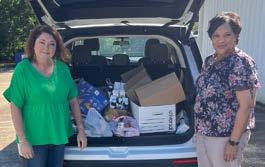


PEPA responded to o er assistance at electric cooperatives a ected by Hurricane Helene on September 26. Their first stop was Talquin Electric Cooperative in Quincy, FL, followed by work with Central Florida Electric Cooperative in Chiefland, FL. Cooperation Among Cooperatives is one of the seven cooperative principles. PEPA is proud to lend a hand when a sister co-op is in need.

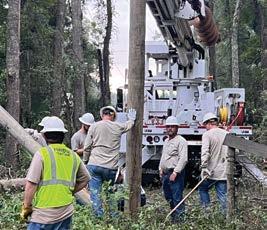












Pontotoc Electric Power Association will be closed on Thursday, Nov. 28 and Friday, Nov. 29, for the Thanksgiving holiday.


A PEPA dispatcher is on duty 24 hours per day, seven days per week in the event of an outage or emergency.












by Jennifer Johnson








Hayden Mitchell Bails would have fit right in with the pioneer homemakers of years ago. The PEPA member said she learned lots of homemaking skills from her Memaw, the late Cheri Kay Mitchell.
“We spent a week or two every summer at her farm. She taught me how to crochet and hand sew, cooking, and baking. I have three siblings, and she tried to teach us all, but I guess I was the one who ‘took’ to it the most.”
Mitchell said Memaw was really involved in her church, and they also benefitted from her creativity. “I remember one time she made a seven-foot banner that was purple and gold. It was all over the place while she was making it. They still use it at the church today.”
Bails enjoys cooking, baking, canning, gardening, quilting, crocheting – “a little of it all,” she said. She’s not afraid to try new things or approach things in an unconventional way. Bails uses her math skills to create quilt blocks and draws her own patterns for sewing.
She even took piano lessons for 11 years growing up. She has her great grandmother’s piano and occasionally still plays it.
She’s a self-taught seamstress, buying her first sewing machine for $50. Later, her other grandmother Judy Crowder gave Bails her machine from the 1970s to use for her projects.
As for her cooking, Bails said she looks at recipes on social media a lot. “I’ll see something that looks good, and I’ll try it once just the way it’s written. After that, if we like it, I’ll add my own touches. I never make things exactly the same way twice. I’m always searching for a better recipe.”
Bails usually has a garden in her backyard, with raised beds growing tomatoes, cucumbers, and beans. She has not grown as much this year, as they are expecting a baby in February 2025.
She makes her own bone broth too. “I bought two pounds of marrow bones to make the broth for soups this winter." When her husband kills a deer, he saves the femur bone for Bails, so she can use it to make broth. They get the deer processed and use the meat,























never needing to purchase ground beef at a store. She hopes to raise chickens at some point too.
Reminiscent of the cooks of the past, Bails said she “measures with her heart.” That is, unless she’s baking. She said baking is her favorite, and she likes the science involved in it. In fact, her cinnamon roll recipe uses grams for measurements. Bails purchased a special scale for that.
Her cinnamon rolls have become a favorite, but she also makes a lot of homemade bread. She gives out tins of cookies at Christmas, and she enjoys cooking food to take to husband Nick’s family gatherings.
Bails said she prefers taking the time to make homemade gifts for friends and family. “To me, what a homemade meal and baked goods tell the recipient is that I care about them. It says, ‘You mean something to me.’”


Bails grew up in Kosciusko and attended Holmes Community College. That’s where she met Nick. “We were in speech class together, and apparently I ‘dissed’ him the first day and asked someone else to partner up with me in the class. Later, he invited me to Fellowship of Christian Athletes. I also started going to the Baptist Student Union, and he was there. We’ve been together ever since.”
After finishing college at Holmes, Bails got her bachelor’s degree in educational psychology at Mississippi State University. She has done some graduate work at Arkansas State University.
She said she ended up working in finance by accident. “My dad knew Lori Deason, the operations manager at Cadence Bank. Lori asked him if I might want to work there part time. Cadence had a layo later on, so I found myself looking for a job.”
Nick found work in Oxford, so Bails started her search there. She took a job with MTrade, a software company for mortgages, and moved up in the company through several promotions. She works from home, which is exactly where she loves to be.
Bails is thankful for the life she has, and she appreciates the things her grandmother taught her. “I’ve been blessed beyond measure by God. This is how I keep Memaw’s memory alive. I think it’s important to carry on the things I learned from her. My generation sometimes wants to break that mold of homemaking, but that wasn’t my path. These things are important to me.”


DOUGH
420 grams plain flour
170-227 grams lukewarm water
28 grams room temperature butter
1 large egg
50 grams sugar
1 ¼ teaspoon salt
9 grams active yeast
1 teaspoon vanilla extract
FILLING
1 stick unsalted butter, melted
2 tablespoons cinnamon
1 ½ cups brown sugar
ICING
4 ounces cream cheese, softened
½ stick butter, room temperature
2 teaspoons vanilla
¼ teaspoon salt
about ¼ cup milk
2 cups powdered sugar









Start with 170 g lukewarm water. Add yeast and sugar and mix. Set aside until bubbly. Combine all other ingredients and the bubbly yeast mixture. Put in a stand mixer or stir to combine. If using stand mixer, use a dough hook and run on high for a couple of minutes until forming a smooth ball. (If mixing by hand, sprinkle flour on counter and knead dough until smooth ball is formed.) Put in a bowl and cover with a clean towel. Let rise for one to two hours or until dough has doubled in size.
Combine ingredients for filling. Measurements for filling depend on how much you want. Adjust as needed.
Roll out dough on a floured surface, trying to make it as rectangular as possible. Spread filling evenly. To roll cinnamon rolls, either roll into a log and slice or cut into strips and roll individually.
Place rolls in a greased pan, cover with a clean towel, and let rise for another hour or until doubled in size. Bake at 375 for 15-20 minutes. Goal is to not be too brown but not doughy.

Icing: Beat together cream cheese and butter until smooth. Add vanilla and salt and mix. Slowly add powdered sugar. Add in milk as needed to combine.




With anksgiving just around the corner, here are some delicious options for your dessert plans!
Betty Armstrong, PEPA Retiree
INGREDIENTS
3 cups sugar
2 sticks butter, no substitutes
1 small carton whipping cream
6 eggs
3 cups cake flour
2 teaspoons vanilla
Cream butter and sugar. Add eggs one at a time, and beat after each. Add three cups cake flour that has been sifted twice. Add whipping cream and continue beating. Add vanilla. Pour into greased and floured tube pan. Cook at 325 degrees for 75 minutes. Start in a cold oven. This is Criss Armstrong’s recipe.
Jennifer Johnson, PEPA HR Manager
INGREDIENTS
1 box red velvet cake
1 ½ tubs cream cheese frosting
1 block cream cheese
Bake cake as directed and allow to cool. Crumble cake. Mix cream cheese and frosting, then add crumble cake pieces and mix. Roll into balls and coat with almond bark.
INGREDIENTS
1 stick butter
2 cups sugar
2 cups plain flour
½ cup Crisco
3 tablespoons cocoa
1 teaspoon cinnamon
1 cup hot water
½ cup buttermilk
1 teaspoon soda
1 teaspoon vanilla
2 eggs
Mary Williamson, PEPA Collections Manager
INGREDIENTS
Nonstick baking spray
2 cups sugar
4 large eggs
1 teaspoon baking soda
1 teaspoon salt
1 ½ cups mashed ripe banana
FROSTING
2 sticks butter, softened
2 cups confectioner sugar
1 teaspoon vanilla
2 sticks butter, softened
1 tablespoon vanilla
3 cups all-purpose flour
1 teaspoon ground cinnamon
1⁄3 cup buttermilk
1 8-ounce can crushed pineapple
2 8-ounce packages cream cheese
1 tablespoon lemon juice
Preheat oven to 350 degrees. Spray three 9-inch baking pans with nonstick baking spray. In a large bowl, beat butter, sugar, and vanilla at medium speed with a mixer until flu y. Add eggs, one at a time, beating well after each addition. In a medium bowl, combine flour, baking soda, cinnamon, and salt. Add to the butter mixture alternating with the buttermilk, beginning and ending with flour mixture, beating just until combined after each addition. Add the bananas and pineapple, beating until combined. Using a measuring cup, spoon batter into pans, one scoop at a time to ensure an even distribution. Slam pans against the counter to get any air bubbles out of batter. Bake until a wood pick inserted in the center comes out clean, 25-35 minutes. Cool cakes before frosting.
Frosting: Beat the butter and cream cheese together until smooth and creamy. Beat in the confectioner sugar in increments. Lastly, beat in the lemon juice and vanilla. Spread some frosting between the layers. Spread the remaining frosting over top and sides of cake. Garnish with coconut and nuts if desired.
FROSTING
1 stick real butter
3 tablespoons cocoa
1 box confectioners' sugar
6 tablespoons milk
1 teaspoon vanilla
1 cup chopped pecans
Cake:
Sift together sugar and flour. Mix and set aside. Put in sauce pan: butter, Crisco, and hot water. Bring to boil and pour over sugar and flour mixture. Stir together and add buttermilk and soda (mixed), 2 eggs (slightly beaten), cinnamon, and vanilla. Makes a thin batter. Cook in 11 x 16 pan at 400 degrees for 20 minutes.
Frosting:
Melt butter, cocoa, and milk. Bring to boil. Remove from heat and add confectioners' sugar, nuts, and vanilla. Pour over cake while hot.























There are many benefits of being a member of an electric cooperative, and a major benefit is the retirement of capital credits. Singing River Electric Cooperative’s (SRE) board of directors recently approved a retirement of more than $3.5 million in SRE capital credits to our membership; this represents capital credits for the year 1998.
Our generation and transmission cooperative, Cooperative Energy, also returns capital credits to SRE members; they are returning $1.56 million in capital credits to our membership for the year 1994.
As a member, you have a share in the earnings of your not-for-profit electric cooperative. SRE’s rate revenue is used to operate, make payments on loans, and make improvements to the electric system. Any remaining revenue is allocated to the members in the form of capital credits. The amount of capital credits assigned to a member is based on the amount of electricity used during a particular year. When funding is available, Singing River Electric’s board of directors can approve retiring a portion of a members' capital credits in the form of a bill credit or check; the same applies for Cooperative Energy. As always, this year’s


retirement is dependent on potential tropical storms or hurricanes through the remainder of this year’s storm season.
SRE members during the years 1994 and 1998, with an account that is still active and receiving a monthly billing statement, will automatically receive either a bill credit or a check depending on the credit amount. These members do not have to fill out any paperwork to receive their capital credits.
Previous SRE members who had an account during the specified years, but no longer have an active account, can visit our website at singingriver.com or call any SRE o ce between Nov. 1 and Dec. 31 to receive instructions and download the necessary paperwork to claim their capital credits. Completed documentation must be returned to SRE’s Lucedale o ce by 5 p.m. on Tuesday, Dec. 31, 2024.
We hope these returned capital credits help you and your family this holiday season. On behalf of our board and employees, I wish you a Happy Thanksgiving.
by Brian Hughey





























Properly operating your heating system during colder months can make a di erence with energy savings. Pay special attention to the thermostat setting. Do not confuse the “Heat” setting on your heat pump with the “EmHeat” (Emergency Heat) setting.

• “Heat” allows the heat pump to warm your house by capturing heat through the change from liquid to gas freon. This setting also allows the unit to avoid reliance on heating strips.
• “EmHeat” relies solely on the heating strips located in the furnace. This method of heating is much more costly than letting your heat pump do its job.
• Set your heating temperature no higher than 68 degrees.
• Avoid using the “EmHeat” setting.
• Increase the temperature on your heat pump only 1-2 degrees at a time; turning it up by more than 2 degrees will cause your heating strips to cycle on.


An 11-man Singing River Electric crew traveled to Florida in late September to restore power outages after Category 4 Hurricane Helene.
The linemen first traveled to Talquin Electric Cooperative based in Quincy, Florida, where 55% of their 57,000 meters were without power after the storm.
The crew then traveled further east to help Central Florida Electric Cooperative based in Chiefland, Florida, who had more than 18,000 of their 35,231 meters without power.
Central Florida Electric posted this on their Facebook page shortly after the storm: “Crews have been working tirelessly, day and night, rain or shine, to clear the massive amounts of debris,

downed trees, and broken poles caused by Hurricane Helene. This is not just a repair job — it’s a full-scale rebuild of our electric system after a catastrophic, deadly storm. Restoration will be an extended process, and we urge everyone to practice compassion. Many of our neighbors have lost homes, businesses, and more. This will take the entire community coming together to recover.”

“We were asked to send linemen to Florida following Hurricane Helene, and our answer was yes, as that is the cooperative way,” said Singing River Electric General Manager and CEO Brian Hughey. “Our linemen are always eager to put their skills to use to restore power for fellow electric cooperative’s members.”


















With the Benndale and Rocky Creek substation areas now open for fiber internet sign-ups, all Singing River Electric members in George, Greene, Perry, Stone, and Wayne counties now have access to reliable high-speed internet from your trusted local provider!



• Unlimited data



Whether you are a speed fanatic, an entertainment enthusiast, or an everyday scroller, Singing River Connect has the perfect package to fit your home and business needs.



• Free installation – a $200 value
• Equally fast upload and download speeds







• No equipment fees - modem and router included
• No annual commitments

• Free My SR Connect App to easily manage and monitor your network

• 24/7 tech support































Cassotte and Kreole substation areas




Connecting the dots.



Planning the most efficient approach to fiber deployment.
Monaco Lake, Fountainbleu, Singing River Mall, Gautier, and Hamill Farm substation areas


Building a network from the ground up.

Sunplex, Ocean Springs, Gulf Park, Fort Bayou, Martin Bluff, Hickory Hills, St. Martin, and Tucker Road substation areas




Forts Lake, Helena, Helena Industrial, and Escatawpa South substation areas



Wade, Benndale, Rocky Creek, Leakesville, Lucedale North, Vancleave, Joe Batt, and all previously opened areas








Wade, Benndale, Rocky Creek, Leakesville, Lucedale North, Vancleave, Joe Batt, and all previously opened areas






Singing River Electric employees have been out and about in our local communities this fall – visiting with our members and partnering with local organizations. Our e orts include registering voters at Mississippi Gulf Coast Community College poll events as part of Co-ops Vote, attending the Lucedale Downtown Merchants Second Saturday event to talk about linemen work, and setting up for the Pascagoula River Audubon Center’s Hummingbird Festival.

















When upgrading to smart technology at home, consider the purchase cost as well as long-term savings over the lifetime of the appliance. Here are some smart devices that will take the work out of saving energy.
Smart thermostats save energy by automatically adjusting your heating or cooling system. For example, you can save as much as 10% a year on heating and cooling costs by adjusting your thermostat 7 to 10 degrees from its normal setting for eight hours a day, according to the Department of Energy (DOE). You can program a smart thermostat to change the temperature when you are asleep or away or use a smartphone app to adjust your thermostat settings. Some models use artificial intelligence to maximize e ciency by learning your patterns and preferences. Prices range from $80 to $250, depending on features. Smart thermostats do not work with all heating and cooling systems, so check compatibility before you buy.



water heater with a heat pump water heater, consider a model equipped with smart technology features, including Wi-Fi capabilities for controlling it remotely or during peak demand times, viewing the amount of hot water available and tracking energy use.

pump
Your water heater can also be controlled for energy savings. Installing a timer on your electric water heater can save 5% to 12% of the energy it uses by turning it o at night and when you don’t need to use hot water, according to the DOE. If you are already planning to replace your electric storage
Smart lighting gives you the power to control lights in your home remotely or set a lighting schedule that fits your lifestyle. This can be beneficial for energy savings and provide home security benefits. If you or other members of your household are notorious for leaving lights on, smart lighting can help. Numerous features are available, including dimmable bulbs and color-changing e ects.
Smart light switches are another budget-friendly way to control lighting. They’re priced from about $10 to $50. Smart switches with dimmable options are available and can also control ceiling fans. Some have occupancy sensors that turn lights o when no movement is detected in a room.
A smart plug fits into any outlet to control whatever is plugged into it. Set them to automatically turn o and on or control them using a smartphone app. Prices range from $8 to $25.








As we close out another year, it’s a moment to reflect on our collective achievements in 2024, which included many challenges and successes. I hope to see you at Southern Pine’s Annual Meeting on Thursday, Nov. 14, as we do just that.
Members Helping Members is the theme for this year’s meeting. We are excited to have recently launched this significant program, which embodies the cooperative principle of Concern for Community. It’s a testament to our shared commitment to each other and our community. I can’t think of a better way to live out this principle than through the Members Helping Members program.
The benefit of members working together takes us back some 86 years. That was when a group of members just like you got together and figured out how to provide electricity to rural homes and businesses where no one else was willing to go. This accomplishment required determination, courage, creativity, and, quite simply, a lot of hard work.
A lot has changed over the last 86 years. Take, for instance, our increasing dependence on electricity. This increase in reliance on electricity has changed members’ expectations over the years. Eightysix years ago, the reliability expectation was lower when members had electricity one day and not the next. Today, I like to say that we work in a 100% expectation business, where members expect that when they flip that light switch, the lights come on 100% of the time.




This expectation is where the tension between a ordability and reliability exists. While having 100% reliability may not be achievable, our goal is to get as close as possible while not losing sight of a ordability. As we all know, costs rise over time. However, it has been decades since we have seen the cost increase that we’ve all experienced over the last three years. Everything we do, whether purchasing wholesale power, cutting rights-of-way, or installing a new service, is more expensive than ever. Maintaining the proper balance between a ordability and reliability is increasingly more challenging.
Despite the challenges we face, I want to assure you that the men and women here at Southern Pine are as determined, courageous, and hardworking as those 86 years ago. We are committed to providing the reliable and a ordable electricity our members expect and deserve.

by Chris K. Rhodes
President/CEO Southern Pine Electric


















THURSDAY, NOV. 14, 2024
THE JORDAN BUILDING 13491 HWY 28 l TAYLORSVILLE, MS
DOORS OPEN: 10 A.M. BUSINESS MEETING: 11 A.M.
Please join us for Southern Pine’s 2024 Annual Membership Meeting. Be sure to visit the Lowe’s winterization booth for tips and ideas to help lower bills, on-site demonstrations, and free energy saving supplies. Learn more about the new Members Helping Members program including benefits that can directly help your community. Don’t miss the Member Spotlight booths where we showcase our small business owners and you can receive free samples of their goods and wares. Good food, fellowship, and door prizes galore!



The Taylorsville District serves members across Covington, Jasper, Forrest, Je erson Davis, Simpson, Smith, and parts of Clarke and Jones counties, with over 3,535 miles of line. With 22,482 members, the district’s 48 employees bring power to our communities with safety, reliability, and a ordability in mind.
Despite facing storms, hurricanes, ice storms, and tornadoes, the team remains committed to serving our members. With a


Mike Kennedy has served Southern Pine members for over 37 years, starting as a tree trimmer and working his way to district manager three years ago. Along the way, he held various roles, including journeyman lineman and substation supervisor.
combined 667 years of experience, their dedication never wavers. District Manager Mike Kennedy says, “This is the best team I’ve worked with. We joke like family, but when it’s time to serve, nothing comes before our members. They count on us, and we do everything we can to deliver.” This shared commitment to our communities drives the Taylorsville team every day.
Pine members for over 37 years, starting restoring power after Hurricane Katrina.
One of Mike’s favorite memories is restoring power after Hurricane Katrina.
“After six days of outages, we fi nally got the power back. Seeing members cheering with their porch lights on was unforgettable,” he recalled.
Mike values his team’s dedication. “We always say, ‘be right there,’ no matter the time, and that commitment is powerful,” he said.
Mike and his wife, Christy, have been married for 31 years and have two children, Weston and Abbi. He enjoys family time, hunting, and fi shing.


Kevin Amason has been a field supervisor for three years, following 20 years as a journeyman lineman and serviceman. His favorite part of working at Southern Pine is the family atmosphere and the wonderful people he works with, a sentiment his coworkers share.
One of Kevin’s most memorable experiences was restoring power after Hurricane Katrina in 2005.
“After working day and night, getting all the lights back on was an incredible accomplishment,” he recalls.
Kevin and his wife, Krista, have been married for 30 years and have two sons, Trevor and Trenton. In his free time, he enjoys deer hunting, traveling to Colorado for elk hunts, and taking family vacations.


Lisa Boone joined Southern Pine 27 years ago as a member service representative and moved on to dispatch, service order clerk, and work order clerk. She has served as o ce supervisor for 14 years. Lisa said her favorite memories of Southern Pine are when the employees come together when storms roll in.
“We are all hands on deck during storms, and everyone works together with one goal in mind—to bring the power back to our members safely,” she said.
One of the best parts of her job is being here when the members need help and working with a great team that feels like family.
Lisa and her husband, Ken, have been married for 35 years. They have three children and six grandchildren. Lisa loves spending time with family, camping, and shopping.



RUSTY BLAKENEY — 46 YEARS OF SERVICE
Rusty serves members in Covington, Forrest, and Je Davis counties and has worked in the area since before the branch was established.
“The role of serviceman has changed a lot, but I still love my job,” Rusty says. “The fellowship with coworkers and members is one of the best parts. I’ve got some great members—they’re really nice people.”
Originally from River Flats in Smith County, Rusty lives in Rawls Springs with his wife of 25 years, Sandy. They have five children and 15 grandchildren. In his free time, Rusty enjoys farming, fishing, and hunting.
THOMPSON
Mechanic Shop Supervisor Bobby Thompson has witnessed many changes in his 45 years at Southern Pine Electric. After 31 years as a mechanic, he became a supervisor, leading a skilled team that keeps Southern Pine on the road.
Bobby’s proudest moment was after Hurricane Katrina, when the team came together to overcome adversity, clearing roads, keeping trucks running, and restoring power.
Bobby and his wife, Martha, have been married for over 50 years. They have three sons and four grandchildren—Kaden, Karson, Jace, and their first granddaughter, Dakota Jane, born this year. His family is his pride and joy.
53
EMPLOYEES
667 Years of combined service
Miles of line Over
22,482 Meters
3,535 76,750 POLES
With 45 years of service to the members of Southern Pine, Leslie said the people are his favorite part of the job. He’s served on the right-of-way as a lineman and as a serviceman for the past 35 years.
Leslie likes to sleep when he’s not at work and “just likes my job.” Leslie is great at what he does, and everyone is happy he’s here and likes him, too.
Leslie is a newlywed who has been married to Patricia for four months. He has two children and nine grandchildren. Leslie and Patricia live in Magee.
JIMMY ARENDER — 44 YEARS OF SERVICE
Construction Supervisor Jimmy Arender started as a tree trimmer and worked his way up over a long career. One of his standout memories is helping bring power to remote villages in Guatemala.
At home, Jimmy enjoys restoring power after storms and helping others. He loves serving God, preaching the Gospel, farming, and spending time with family.
Jimmy has been married to Brenda for 23 years, and they have five children and six grandchildren: Brooklyn, Bryson, Sawyer, Sadie, Addison, and Ailey. They live in Raleigh.
4
21,246 TRANSFORMERS LINE CREWS
4 SERVICEMEN Counties
9



























As the temperatures drop, it’s time to get your home ready for the colder months ahead. Winterizing your home not only keeps you warm and safe, but it can also help you save money on your electric bill. Here are five simple tips to make sure your home is cozy and e cient this winter:
Seal Drafts and Cracks. Drafty windows and doors can let cold air in and warm air out. Check for gaps around windows, doors, and other openings, then use weatherstripping or caulk to seal them. A well-sealed home reduces the strain on your heating system, saving energy and money.
Insulate Properly. Good insulation is key to keeping the heat where it belongs—inside your home. Check your attic, walls, and floors for proper insulation. Adding extra insulation can significantly reduce your heating costs and keep your home comfortable.
Service Your Heating System. Make sure your heating system is running e ciently by having it serviced before winter hits. A well-maintained system uses less energy, and regular maintenance helps prevent unexpected breakdowns when you need it most.




Use a Programmable Thermostat. A programmable thermostat allows you to control your home’s temperature more e ciently. Lower the temperature while you’re away or asleep, and set it to warm up before you return. This simple adjustment can help you save on your energy bill without sacrificing comfort.
Reverse Your Ceiling Fans. Did you know that reversing your ceiling fans in the winter can help circulate warm air? Set your fan to run clockwise at a low speed to push the warm air near the ceiling down into the living space, making rooms feel warmer without turning up the heat.
By taking these easy steps, you can stay warm and comfortable this winter while keeping your electric bill in check. At Southern Pine, we’re here to help you save energy and stay safe all season long! For more tips and ideas, visit southernpine.coop.

Wishing You and Your Family a Warm and Wonderful









At Southern Pine Electric, we are grateful for the privilege of serving you, our members. As we reflect on this season of gratitude, we are reminded that the heart of our cooperative is you—the families, businesses, and communities we proudly power every day. This Thanksgiving, let’s celebrate the power of community and the blessings we share together. Thank you for your trust and support as we work to provide safe, reliable, and a ordable energy to brighten your homes and lives. Happy Thanksgiving from our family to yours!
“Gratitude turns what we have into enough.”












































Cooperation Among Cooperatives is one of our seven cooperative principles. The best example of this principle in action is linemen assisting other cooperatives after damaging storms. More often than not, the mutual aid provided is within our state. However, the extensive damage caused by Hurricane Helene activated the national cooperative mutual aid network.
Even before Hurricane Helene made landfall, the Electric Cooperatives of Mississippi started coordinating the e ort to assist Florida electric cooperatives. On Friday, Sept. 27, 280 linemen from 20 Mississippi electric cooperatives were headed to Florida. Linemen are used to answering the call to restore power after storms. We had twelve linemen volunteer to go to Florida. They finished the job at Talquin
Electric Cooperative in Quincy by Sunday, Sept. 29, and were sent to Suwannee Valley Electric Cooperative in Live Oak. The crews returned from Florida on Friday, Oct. 4.
The Electric Cooperatives of Mississippi also coordinated the e ort to assist cooperatives in Georgia and 121 linemen from nine Mississippi electric cooperatives stepped up. Twelve of our linemen headed to Altamaha EMC in Lyons on Saturday, Oct. 5. Immediately after Hurricane Helene, every meter in their service area was without power. In initial reports, this cooperative in eastern Georgia was reporting 1,000 broken poles and another 500 damaged poles. Mutual aid crews work 16-hour days every day until the job is done. The crews returned from Georgia on Thursday, Oct. 17.




Austin


Jerred
Justin
Bruce
Dennis
Dwayne


Anthony
Hayden
Chad
Seth
Josh
Dexter



Our automated system to make payments and report outages has a new number: 844-975-2728
If you need to speak to a Member Services Representative, call 800-287-8564.











As the weather gets colder, it’s important to focus on ways to reduce heat loss from your home. Here are four simple winter energy e ciency tips that are relatively inexpensive, and most can be done by the average homeowner.

Caulk Windows
Stop cold air from infiltrating your home by using caulk to plug holes, cracks and open seams around the exterior of your house. Either use a high-quality caulk or expanding foam sealant and fill any and all air-leaking gaps.

Inspect the weather stripping around all exterior doors to ensure that it is not ripped, crushed or missing. Try closing the door and check for air-leaking gaps around all four edges of the door. If you see sunlight shining through, you’ll need to seal the spaces with weather stripping.





Seal Duct Work
Air conditioning and heating ducts that leak air into unheated spaces can add hundreds of dollars a year to your heating and cooling bills. Properly sealed and insulated ducts increase e ciency, lower your energy bills and can often pay for themselves in energy savings.

The most e ective use of insulation is in the attic. Unfortunately, most homes have either no insulation or not enough insulation in the attic. Attics are recommended to have a minimum of R-38 insulation, which is typically between 10 and 14 inches deep.





Bruce Butler, Construction Crew Foreman








Sergeant Butler was called up for active duty in the Army in November 1990. He served for six months during Desert Storm and was stationed in Saudi Arabia. He returned home just four days before his wedding.
Eddie Cole, Dispatcher




Private First Class Cole served in the Army for two years and was stationed at Forts Knox, Lee and Stewart. He drove a 10-ton diesel truck for tank refueling and received special training in Germany and California.
Anthony Harris, Lineman

Private First Class Harris served in the Army for four years. He attended Infantry School at Fort Benning before being stationed at Camp Shelby.

Lance Corporal Higgs served in the Marine Corps for four years. He was a squad machine gunner with the Second Law Enforcement Battalion at Camp Lejeune and a patrolman with the Provost Marshal’s O ce in Japan.

Sergeant Keller was also called up for active duty in the Army in November 1990. He was stationed in California for six months ready to deploy to the Middle East if Operation Desert Storm escalated.







Bruce has worked for Southwest Electric for 38 years as a Serviceman’s Helper, a Lineman, a Serviceman and a Crew Foreman. He supervises a construction crew daily and oversees the installation of new services. Bruce and his wife, Kim, have two sons.

Eddie has been with Southwest Electric for four years. He takes calls, dispatches crews to restore power outages and monitors the entire distribution system. Eddie and his wife, Julia, have one son, one daughter, one grandson and two granddaughters.
Anthony has worked at Southwest Electric for three years. He is on a construction crew of five linemen. They install new services, change out poles, relocate services and perform general maintenance. Anthony has four children.
Zeb has worked for Southwest Electric for one year. He is on a construction crew of five linemen. Construction crews are most known for replacing broken poles after storms, but they also work every day installing, maintaining and replacing material on the distribution system.
Jr has worked for Southwest Electric for 36 years in the right-of-way department and the shop. He is Lead Mechanic maintaining a fleet of 55 large and small trucks and 10 oroad vehicles and trailers. Jr has one son and one grandson.
Southwest Electric would like to thank all veterans for serving their country, whether during a time of peace or war.





Our o ces will be closed on November 28 and 29 to observe the Thanksgiving Holidays. If you experience an outage or emergency, please report it on the SmartHub app, text ‘OUT’ to 844-975-2728 or call 800-287-8564.











Southwest Electric is proud to partner with the Electric Cooperatives of Mississippi’s initiative Co-ops Vote MS. This non-partisan program was designed to encourage voter registration and education. On September 17, National Voter Registration Day, we held a voter registration drive at the Natchez campus of Copiah-Lincoln Community College. We were joined by the Adams County Circuit Clerk’s o ce and Cooperative Energy, our wholesale power provider in Hattiesburg.
For more information about the Co-ops Vote MS initiative, please visit coopsvotems.com.



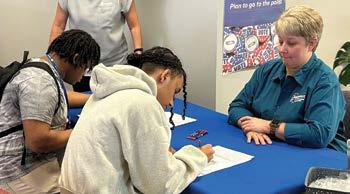
Washington National Cathedral Jefferson, FDR, MLK Memorials World War II Memorial Arlington National Cemetery Iwo Jima Memorial Vietnam Veterans Memorial
For more information, see your Guidance Counselor or call Southwest Electric at 601-437-1359. You can also visit southwestelectric.coop/youth-leaders.


Are you a leader in your community? If you are an 11th grader served by Southwest Electric, make this year memorable by participating in our Cooperative University on December 5. Students selected will attend the 2024 Leadership Workshop in Jackson and a tour of Washington, D.C. There are plenty of trees out there. Never use utility poles for deer stands.










































As November kicks o , it’s hard to believe we’ll soon be gathering with family and friends to celebrate the holiday season. This festive time of year brings joy and warmth, but as the weather gets cooler and we spend more time indoors, the holidays can also bring increased energy use and a higher risk of electrical and fire hazards.
As your local electric cooperative, our team at Twin County Electric cares about your well-being. This month, I’d like to share a few practical tips to help you stay safe and e cient during the holiday season.
My family truly enjoys decorating our home for the holidays. Before we deck the halls, I always check electrical cords and light strands to make sure they aren’t frayed or damaged. This gives us peace of mind, knowing our holiday lights are ready to safely brighten our home. I also double check the lights we use outside to make sure they’re rated for outdoor use.
Like many households, we also enjoy holiday-scented candles. While festive, candles can create fire hazards and should never be left unattended. One of the best and easiest ways to safeguard your home is to test smoke alarms often. I test mine on the first of each month, so it’s easy to remember. Testing smoke alarms only takes a few seconds and could save lives, so make it a habit.
Spending more time indoors with a few more guests in the home can really impact home energy use. By taking a few small steps to save energy during the holiday season, you can lower your bills. I like to remind my family members to mind the thermostat. Since heating and cooling makes up the majority of home energy consumption, the thermostat is one of the best places for savings. Lower it a few degrees, especially when you have family or friends stopping by. Good company brings additional warmth to your home.


twincoepa.com




@twincoepa
Hollandale - 662-827-2262 | Belzoni - 662-247-1909 | Greenville - 662-334-9543 | Rolling Fork - 662-873-4233 | REPORT OUTAGES 866-897-7250









There’s no denying one of the best parts of the holiday season is
There’s no denying one of the best parts of the holiday season is the food—not just the meals but the time we spend together in the kitchen. There are many ways to save in the heart of your home, but one of the best approaches is to cook with smaller countertop appliances, such as air fryers, slow cookers, and toaster ovens. These handy appliances consume a fraction of the energy used to heat the oven, creating the perfect recipe for mealtime and energy savings.
I hope you will implement some of these energy-saving and safety tips into your holiday plans. For additional advice, visit our website at www.twincoepa.com. We’re here to help you with safety and savings year-round.
From your friends at Twin County Electric, we hope your holiday season is merry and bright.


stopping by. Good company brings additional warmth to your home.

Your family can also save energy by decorating with LED holiday lights. LEDs are the most energy e cient lighting options available, and they last much longer than traditional bulbs.

by Leslie Holloway
General Manager












































How can smart home technology help me lower my power bill?
by Miranda Boutelle
When upgrading to smart technology at home, consider the purchase cost as well as long-term savings. For example, you may pay a little more for a product with the latest technology, but it could result in significant savings each year and over the lifetime of the appliance.
Here are some smart devices that will take the work out of saving energy.
Smart thermostats save energy by automatically adjusting your heating or cooling system. For example, you can save as much as 10% a year on heating and cooling costs by adjusting your thermostat 7 to 10

Smart technology can make it easier to save energy by simplifying or automating tasks. It can also optimize energy use to reduce waste and improve e ciency.
degrees from its normal setting for eight hours a day, according to the Department of Energy (DOE).
You can program a smart thermostat to change the temperature when you are asleep or away, or use a smartphone app to adjust your thermostat settings. Some models use artificial intelligence to maximize e ciency by learning your patterns and preferences. Prices range from $80 to $250, depending on features. Smart thermostats do not work with all heating and cooling systems, so check compatibility before you buy.

Your water heater can also be controlled for energy savings. Installing a timer on your electric water heater can save 5% to 12% of the energy it uses by turning it o at night and when you don’t need to use hot water, according to the DOE.
If you are already planning to replace your electric storage water heater with a heat pump water heater, consider a model equipped with smart technology features, including Wi-Fi capabilities for controlling it remotely or during peak demand times, viewing the amount of hot water available and tracking energy use. There are a variety of modes, including vacation, e ciency and high demand, which produces more hot water. Some models can notify you or shut o if a leak is detected. Depending on the manufacturer and size of the unit, a smart heat pump water heater may only cost a few hundred dollars more than a standard heat pump water heater.
Upgrading to smart home technologies can make it easy to use less energy at home. Choose options that make the most sense for your lifestyle to optimize savings.

Smart lighting gives you the power to control lights in your home remotely or set a lighting schedule that fits your lifestyle. This can be beneficial for energy savings and provide home security benefits. If you or other members of your household are notorious for leaving lights on, smart lighting can help. Numerous features are available, including dimmable bulbs and color-changing e ects.
Smart light switches are another budget-friendly way to control lighting. They’re priced from about $10 to $50. Smart switches with dimmable options are available and can also control ceiling fans. Some have occupancy sensors that turn lights o when no movement is detected in a room.
A smart plug fits into any outlet to control whatever is plugged into it. Set them to automatically turn o and on or control them using a smartphone app. Prices range from $8 to $25.


A wide variety of smart shades, curtains, and blinds are available, including styles with integrated controls. You can also add smart controls to your existing blinds or curtains. Both options allow you to adjust the tilt of blinds and open or close curtains. Set a schedule, control them remotely or use a voice command paired with a voice assistant, such as Alexa or Google Home. This allows you to reduce cooling needs in the summer and heating needs in the winter. Smart controls start at around $70. To save the most energy, prioritize windows with the most incoming light.
Upgrading to smart home technologies can make it easy to use less energy at home. Choose options that make the most sense for your lifestyle to optimize savings.






















by Scott Flood


You might be surprised to learn that your local electric cooperative doesn’t generate the electricity you use in your home or business. In most cases, your co-op does not own a power plant but instead purchases electricity from an outside source, then routes the power to your community.
For more than 800 electric cooperatives across the country, the source for electricity is a di erent kind of cooperative. Referred to as “G&Ts,” these Generation & Transmission cooperatives exist to help electric co-ops serve their members as reliably and a ordably as possible. Their only members are local electric co-ops, so G&Ts are actually cooperatives that serve — you guessed it — cooperatives.
Across the nation, 64 G&T cooperatives provide access to wholesale (at-cost) power at a better price than each of their member co-ops could obtain on their own. Most G&Ts go beyond the delivery of power to provide sophisticated business resources that would normally be out of reach for local co-ops.
Like your local co-op, G&Ts are not-for-profit organizations that exist to serve the needs of their members. G&Ts generally serve all the co-ops in a specific geographic area.
Cooperative Energy is a G&T in Mississippi. The Tennessee Valley Authority is a public power entity that serves the G&T function in part of the state.
G&Ts employ a leadership team of experts in data, finance, engineering, economic development, environmental management and other important specialties that are essential for electric co-ops. The G&T operates behind the scenes to support the local co-op’s teams, and although G&Ts may be largely unseen, they operate with complete transparency.
G&Ts are best known as the source for at-cost electricity that is generated elsewhere, then delivered to your local co-op over high-voltage transmission lines. Your co-op uses distribution power lines and transformers to then deliver that electricity to your home or business.
Most G&Ts maintain their own power plants, while others purchase power for their members on the wholesale market. Some G&Ts manage a combination of native power generation and purchases. Because a G&T buys enough power to supply all of its member co-ops, it has the bargaining power to secure significantly lower prices than those co-ops could negotiate by themselves. Regardless of how they’re structured, G&Ts help keep your electric bill smaller.
Just as important is the work G&Ts perform in planning. The nation’s energy landscape is changing rapidly. G&Ts constantly work with local co-op sta to study and forecast power needs. They consider how growing communities might a ect the demand for







electricity in the future and work closely with local co-ops when power reliability is challenged, such as times when electricity demand outpaces supply or after a major weather event.
In addition to obtaining the electricity local co-ops need, G&Ts improve and maintain the reliability of the infrastructure co-ops and their communities depend upon. By working with local co-op sta to upgrade transmission lines and deploy substations, they make sure the power will be there for members, like you, when you need it. G&Ts also work closely with government agencies that monitor and manage the nation’s electric grid.
So, while your co-op may not own the power plant that generates the electricity you use every day, it’s part of an even bigger not-forprofit cooperative whose mission is to make your service even more reliable and a ordable. As the power behind your power, just like your electric co-op, G&T cooperatives exist to serve you.
For more than four decades, business writer Scott Flood has worked with electric cooperatives to build knowledge of energy-related issues.




































Yazoo Valley Electric Power Association recently welcomed students from the lineman school at Holmes Community College for a day of learning. Students participated in safety training and learned from Yazoo Valley employees. The HCC Electrical Lineman Program is a 16-week course that teaches students skills required to work in the industry.

















Yazoo Valley Electric Power Association assisted with back-to-back hurricanes in Florida. A crew traveled to assist Talquin Electric Cooperative near Tallahassee before moving on to help Central Florida Electric Cooperative. The next day after the crew arrived home safely, Yazoo Valley sent another crew to help Peace River Electric Cooperative restore extensive damage caused by Hurricane Milton.
Cooperation Among Cooperatives is one of the seven principles electric cooperatives like Yazoo Valley were founded on, and Yazoo Valley is always ready to assist our friends in other areas when needed. Yazoo Valley has also benefited from assistance from other cooperatives after major storms many times over the years.


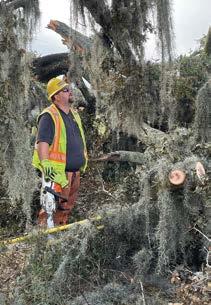









Wade O'Briant
Reggie Green
Coby McCrory
Boone Brazil
John Avery Fowler
James Ellis
Markavius Smith
Garret McClellan
Johnathon Demita
Josh Reeves
Jimmy Wayne Pettis
Cary Lipsey

Eric Woods
Kapin Engleman
Allan Bigford
Philip Franklin
Jessie Duell
Tanner Evilsizor
Taylor Arinder
Christopher Robbins
Jimmy Wayne Pettis
Josh Nordquist
Chase Pearson
Justin Milner
Hunter Vandevere

























How can smart home technology help me lower my power bill?
by Miranda Boutelle
When upgrading to smart technology at home, consider the purchase cost as well as long-term savings. For example, you may pay a little more for a product with the latest technology, but it could result in significant savings each year and over the lifetime of the appliance.
Here are some smart devices that will take the work out of saving energy.
Smart thermostats save energy by automatically adjusting your heating or cooling system. For example, you can save as much as 10% a year on heating and cooling costs by adjusting your thermostat 7 to 10 degrees from its normal setting for eight hours a day, according to the Department of Energy (DOE).
You can program a smart thermostat to change the temperature when you are asleep or away, or use a smartphone app to adjust your thermostat settings. Some models use artificial intelligence to maximize e ciency by learning your patterns and preferences. Prices range from $80 to $250, depending on features. Smart thermostats do not work with all heating and cooling systems, so check compatibility before you buy. Your water heater can also be controlled for energy savings. Installing a timer on your electric water heater can save 5% to 12% of the energy it uses by turning it o at night and when you don’t need to use hot water, according to the DOE.



Smart technology can make it easier to save energy by simplifying or automating tasks. It can also optimize energy use to reduce waste and improve e ciency.

Smart lighting gives you the power to control lights in your home remotely or set a lighting schedule that fits your lifestyle. This can be beneficial for energy savings and provide home security benefits. If you or other members of your household are notorious for leaving lights on, smart lighting can help. Numerous features are available, including dimmable bulbs and color-changing e ects.
Smart light switches are another budget-friendly way to control lighting. They’re priced from about $10 to $50. Smart switches with dimmable options are available and can also control ceiling fans. Some have occupancy sensors that turn lights o when no movement is detected in a room.

Smart heat pump water heaters are equipped with automation features that help you use less energy. Photo Credit: Northwest Energy E ciency Alliance
If you are already planning to replace your electric storage water heater with a heat pump water heater, consider a model equipped with smart technology features, including Wi-Fi capabilities for controlling it remotely or during peak demand times, viewing the amount of hot water available and tracking energy use. There are a variety of modes, including vacation, e ciency and high demand, which produces more hot water. Some models can notify you or shut o if a leak is detected. Depending on the manufacturer and size of the unit, a smart heat pump water heater may only cost a few hundred dollars more than a standard heat pump water heater.
A smart plug fits into any outlet to control whatever is plugged into it. Set them to automatically turn o and on or control them using a smartphone app. Prices range from $8 to $25.
A wide variety of smart shades, curtains, and blinds are available, including styles with integrated controls. You can also add smart controls to your existing blinds or curtains. Both options allow you to adjust the tilt of blinds and open or close curtains. Set a schedule, control them remotely or use a voice command paired with a voice assistant, such as Alexa or Google Home. This allows you to reduce cooling needs in the summer and heating needs in the winter. Smart controls start at around $70. To save the most energy, prioritize windows with the most incoming light.
Upgrading to smart home technologies can make it easy to use less energy at home. Choose options that make the most sense for your lifestyle to optimize savings.
Miranda Boutelle is the chief operating o cer at E ciency Services Group in Oregon, a cooperatively owned energy e ciency company.
Our November issue has a familiar orange friend on the cover.
Sweet potatoes are familiar to those who participate in traditional Thanksgiving dinners as well as Mississippi residents.
Vardaman — in the northern part of the state — is known as the “Sweet Potato Capital of the World.” Mississippi has 172 sweet potato farms and produced the third-highest yield of the crop in the U.S. last year totaling 4.3 million 100-pound bags. In October 1974, then-Mississippi Gov. Bill Waller proclaimed Vardaman the “Sweet Potato Capital of the World,” making it o cial.
Thanksgiving and this month’s Sweet Potato Festival in Vardaman made this issue the perfect choice to tell the story of one of Mississippi’s greatest exports.
(If you take a peek at Page 29, you’ll find food columnist Vicki Leach’s recipe for sweet potato pie.)
November of this year is notable for more than just sweet potatoes.
Depending on when you received this issue, you may have already voted in the Nov. 5 presidential election. If you are reading the column before that date, please make sure to vote.
As a member of an electric cooperative and a resident of Mississippi, you deserve to have your voice heard. You have the power to help determine this country’s leadership.
In an e ort to help our members get informed and participate in the democratic process, we created our Co-ops Vote MS initiative.
The Co-ops Vote MS website — coopsvotems.com — features quick links to important voting information including where to register to vote, our current elected o cials, what elections are occurring this year, and videos of elected o cials talking about the importance of voting, and what they do on a day-today basis.
We hope you have visited the website, and it helped you with either registering to vote or informing you in some way. If not, please visit going forward. We want our members to remember that public policy impacts your co-op’s ability to provide reliable, a ordable power. The best way for your voice to impact public policy is informed voting.
Happy Thanksgiving and we hope you enjoy the issue.

by Michael Callahan

























